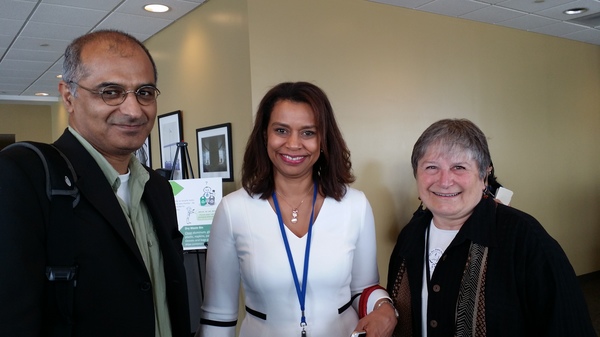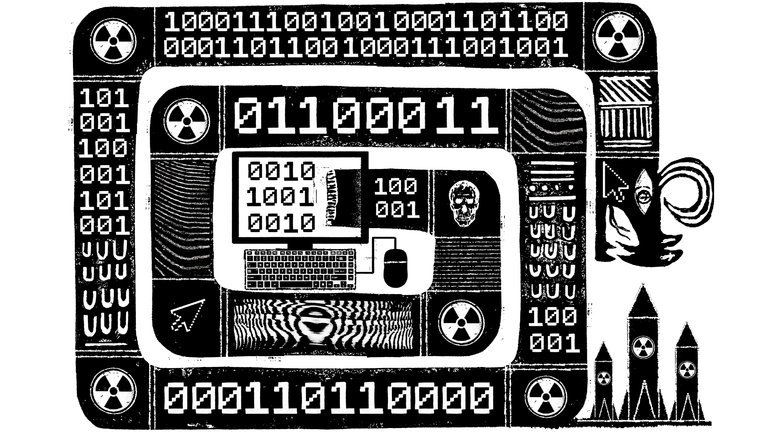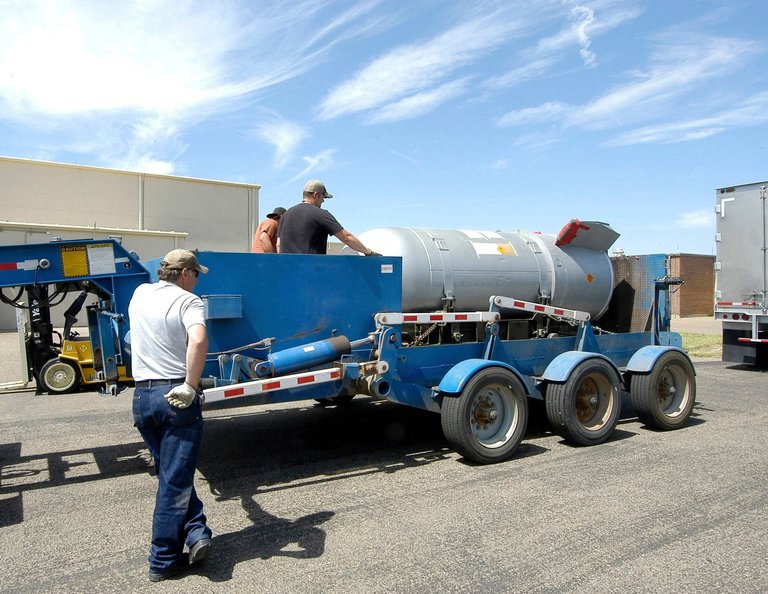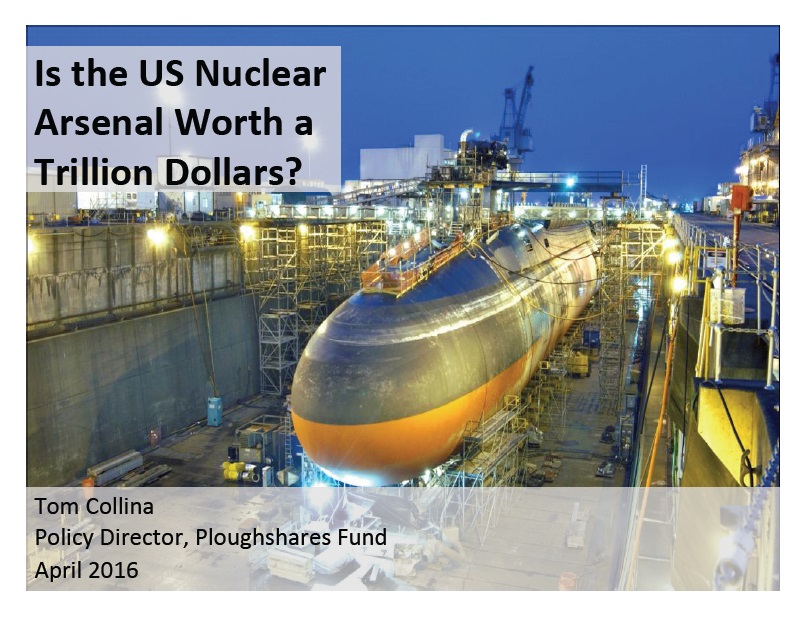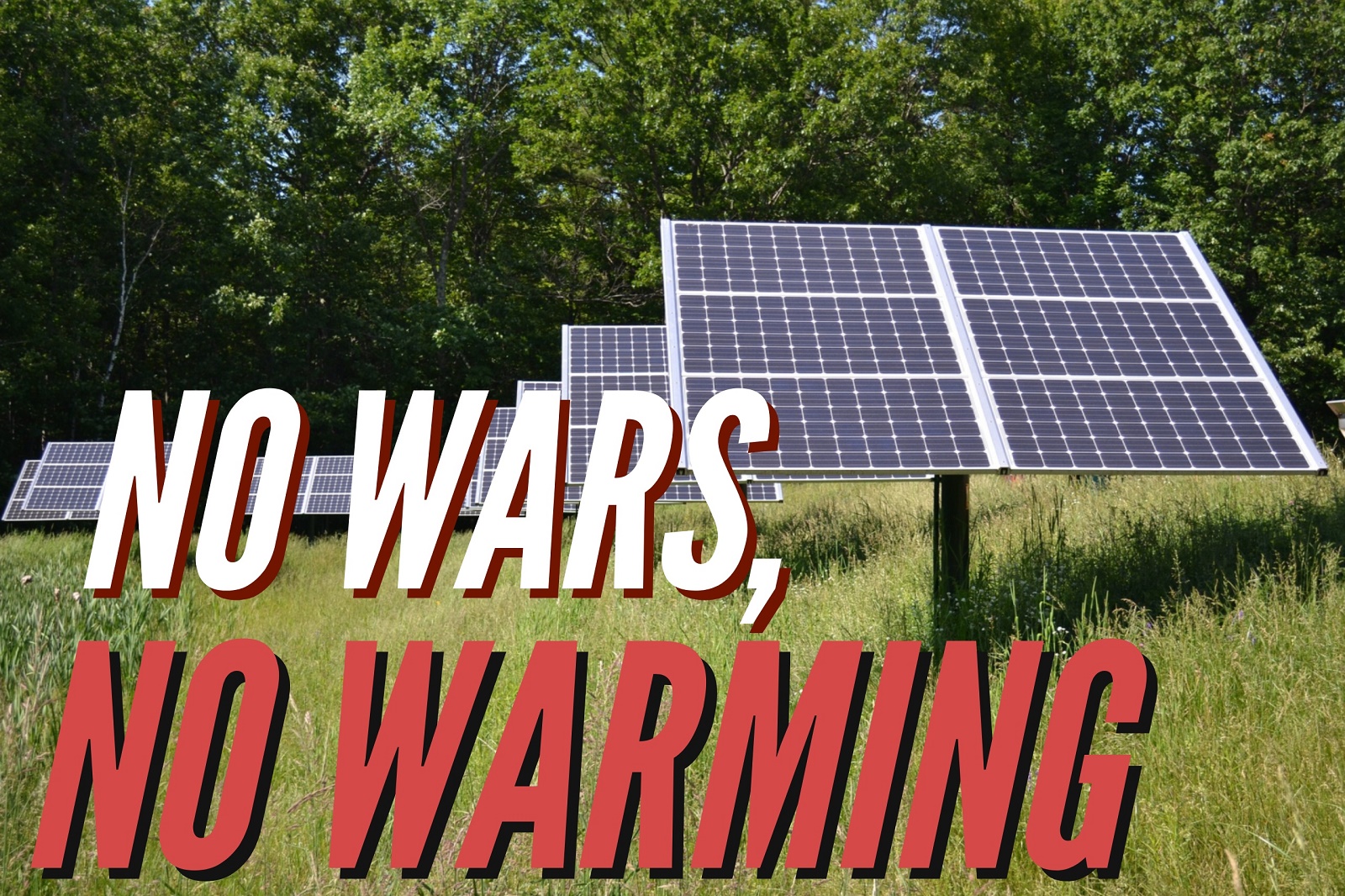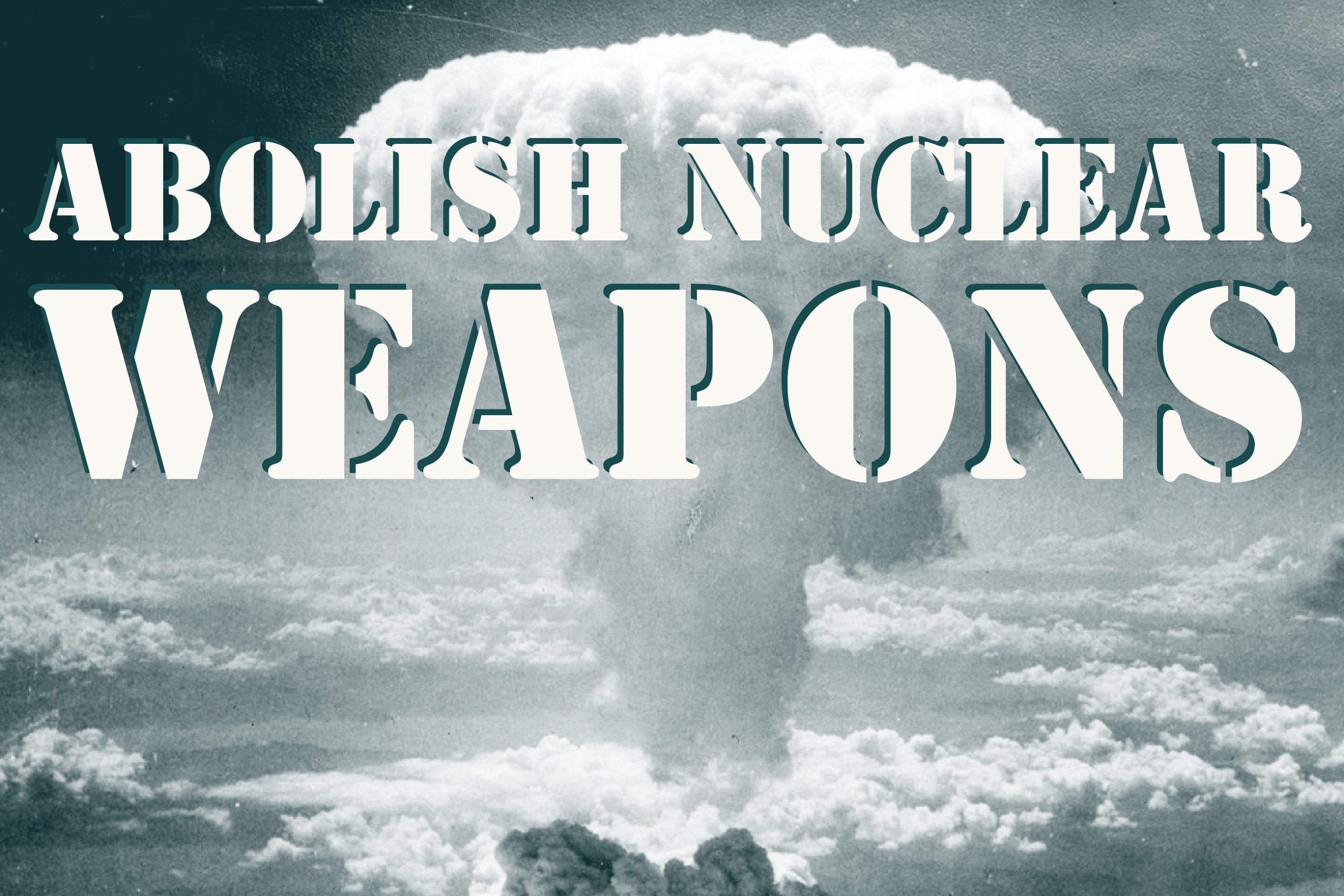
CFPA Executive Director Rev. Bob Moore submitted the following op-ed for publication on August 3, 2022.
Be Active Today to Prevent Being Radioactive Tomorrow!
On August 1, UN Secretary General Antonio Guterres warned in an address to the Nuclear Nonproliferation Treaty Review Conference, “Humanity is just one misunderstanding, one miscalculation away from nuclear annihilation.”
As someone who has been organizing full time for the global abolition of nuclear weapons for the last 45 years, I concur wholeheartedly with this grave warning. August 6 and 9 mark the 77th anniversaries of the atomic bombings of Hiroshima and Nagasaki. Some say that prudent policies have prevented another use of nuclear weapons in war since then.
But the truth is that on numerous occasions, the world has come awfully close to their use again. For example, we’ve only learned recently that a Russian nuclear submarine commander ordered the launching of a nuclear weapon during the Cuban Missile Crisis. It was only luck that a regional commander who happened to be on board overruled him.
People with deep knowledge of nuclear weapons, including former US Secretaries of Defense Robert McNamara and William Perry, and former Commander of US Nuclear Forces Lee Butler, have said that it’s mostly luck that nuclear weapons haven’t been used again.
In the late 1970s, I was a leader in founding the National Nuclear Weapons Freeze Campaign to counter the escalating nuclear arms race between the US and the former Soviet Union. Millions of Americans became active in demonstrations, lobbying, referenda.
Then President Reagan responded to the massive pressure by resuming nuclear negotiations with the Soviets. By 1987, the first nuclear reduction treaty in history verifiably eliminated medium range land based nuclear weapons. More nuclear restraint treaties followed through 2010.
However, starting with President George W. Bush’s withdrawal from the Anti-Ballistic Missile Treaty in 2002, most of those treaties were negated up through President Trump’s withdrawal from the Iran Nuclear Agreement in 2018.
Moreover, the US, Russia, and China are all beginning a new nuclear arms race under the guise of “nuclear modernization.” For the US, that is estimated to cost $2 trillion and have new nuclear weapons deployed for another 70-100 years.
There are also signs of hope. President Biden extended the New START nuclear reduction treaty for another five years through 2026. The UN’s Nuclear Ban Treaty has been supported by 123 member states, several of which have nuclear weapons deployed on their territory. Verifiably banning nuclear weapons globally is the only way to prevent the nuclear annihilation Secretary General Guterres warned about.
Movement toward that ambitious goal only has a chance of succeeding if millions in the US and around the world undertake renewed activism. It’s the only alternative to relying on “mostly luck” to prevent nuclear annihilation. We, average citizens, as a slogan coined in the 1980s phrased it, must become active today to prevent being radioactive tomorrow.
"Will the Nuclear Powers Ever Be Willing to Forgo Their Nuclear Weapons?" -- Lawrence S. Wittner, The Asia-Pacific Journal, February 15, 2021
Abstract: This article examines the reluctance of nuclear-armed nations to divest themselves of their nuclear weapons. After the U.S. government produced and used nuclear weapons to obliterate Japanese cities in 1945, a nuclear arms race ensued among a limited number of nations. Although treaties, agreements, and unilateral actions eventually reduced the number of nuclear weapons in nuclear arsenals, this reversal in public policy was above all the result of massive popular pressure. However, with the decline of popular pressure, the nuclear arms race resumed. Despite the entry into force of the Treaty on the Prohibition of Nuclear Weapons in January 2021, signed thus far by 86 non-nuclear states and ratified or acceded to by 52, the nine nuclear powers have strongly resisted it. Although the Biden administration has begun initiatives to get nuclear disarmament back on track, these actions will fall short of producing the nuclear weapons-free world called for by the new treaty. Furthermore, given continuing international rivalries, it remains unclear whether even limited disarmament initiatives will proceed or will restrain the nuclear ambitions of the nuclear powers.
Click here to read full article.
This documentary film about efforts to bring a nuclear weapon ban treaty into international law and the role of the International Campaign to Abolish Nuclear Weapons, ICAN, is told through the voices of leading activists from several different organizations and countries and the president of the negotiating conference.
This 56 minute documentary film takes the viewer through a brief history of the bomb and the anti-nuclear activism that has pushed to eliminate them ever since their invention. It moves into a consideration of the humanitarian initiative that successfully challenged the dominant security narrative and the historic steps taken since 2010 to turn the treaty from a dream into a reality.
The Treaty went into force on January 22, 2021.
"Biden eyes cuts to Trump nuclear program as critical arms control deadline with Russia looms," by Vivian Salama, CNN, Dec. 29, 2020
President-elect Joe Biden will explore making cuts to the country's nuclear modernization program, potentially reversing Trump administration efforts to enhance America's nuclear arsenal by developing new weapons. Instead, Biden intends to place greater emphasis on arms control, according to two transition officials and an outside adviser to the incoming administration.
Any significant cuts to the program would likely raise concern among hawkish Republicans and potentially some Democrats who believe that expanding America's nuclear program is critical to US national security, particularly as the clock runs out on a post-Cold War-era nuclear agreement with Moscow, which is set to expire just 16 days after Biden takes office.
Biden intends to revisit the more than $1 trillion nuclear modernization program and explore whether the development of new weaponry warrants the expenditure, the three sources told CNN. Specifically, Biden and his top advisers will be looking at whether to reduce Pentagon spending in the overall nuclear modernization strategy and will look to reverse efforts by the Trump administration to develop a new warhead, the three people said.
"The reason we haven’t had nuclear disasters isn’t careful planning. It’s luck." (Benoît Pelopidas and Alex Wellerstein, Washington Post, August 10, 2020)
On the morning of Aug. 9, 1945, the city of Nagasaki, Japan, was devastated by a single atomic bomb detonated over it by U.S. military. Nagasaki wasn’t the original target for the bomb that morning — that was Kokura, a city to its north, which was spared only because mishaps led the Bockscar airplane to arrive at its target several hours late. When it got there, Kokura was covered in clouds and a smoky haze. Due to Kokura’s luck, it was spared — but Nagasaki’s luck had run out.
Seventy-five years after the last time a nuclear weapon was used in war, the United States is planning to extend the life of its nuclear arsenal for half a century into the future, with a modernization plan going as far as 2042. Weapons the size of those used in World War II are considered to be “small” and “tactical” weapons today; most warheads in the American arsenal are dozens of times more destructive than the ones dropped on Japan. And the United States is no longer the only power with nuclear weapons, either.
Which makes it all the scarier to realize that luck — the same luck that spared Kokura and doomed Nagasaki — is one of the main reasons we’ve avoided nuclear catastrophes since then.
The agencies and organizations that manage nuclear stockpiles tend to rely on narratives of total control. They reassure us nuclear weapons have an excellent safety record, nuclear deterrence will prevent nuclear war from happening, and these large expenditures on warheads that could kill millions and millions are not only a good idea, but also necessary to preserve a world in which nuclear weapons won’t be used.
But the historical counterexamples undermine that message: the near miss nuclear accidents that resulted in nuclear warheads coming close to detonation not only in the United States (such as the Goldsboro accident over North Carolina), but also in foreign territory (like the Palomares accident over Spain); the close-calls where U.S. and Soviet early-warning systems failed and informed their users that a nuclear strike had begun; the moments of brinkmanship that led leaders of both nations to have to make decisions that could lead to the deaths of hundreds of millions of people based on incomplete or false information (such as the Cuban missile crisis). Have we avoided unwanted nuclear explosions, and nuclear war, because we have adequately managed and controlled weapons and crises … or because we have been lucky?
Luck, in this context, seems to mean the exact opposite of control. It’s all that prevented bad outcomes when things could easily have gone in a different direction, no matter what anybody wanted. The historical policymakers who have invoked “luck” have included Robert S. McNamara, who was defense secretary during the Cuban missile crisis; Dean Acheson, special envoy of President John F. Kennedy at the time; ambassador Gerard C. Smith, chief U.S. delegate to the Strategic Arms Limitation Talks in 1969; former defense secretary William Perry, former secretary of state George Shultz, former national security adviser and secretary of state Henry Kissinger, former chairman of the Senate’s Armed Services Committee, Sam Nunn, and former head of Strategic Air Command and Strategic Command, Gen. George Lee Butler.
Most people know the Cuban missile crisis was considered by those involved to be “lucky” — as McNamara put it, years later, in an interview with Errol Morris: “At the end, we lucked out. It was luck that prevented nuclear war.” But even in more mundane cases, there are clear indications that fortunate outcomes were achieved with no help at all from the nuclear control practices in the U.S. arsenal.
On Jan. 24, 1961, a B-52 bomber broke apart in flight near Goldsboro, N.C., and two atomic bombs fell free, one in a way that caused its arming sequence to be initiated. Only one safety switch remaining in the safe position prevented a bomb more than 250 times more destructive than the one dropped on Hiroshima from exploding. One could, of course, claim the switch had operated as designed, and thus the event was “controlled,” not “lucky.” But as one retired weapon system engineer from Sandia National Laboratories later explained in a government-produced documentary on the incident, “unfortunately, there had been some 30-some incidents where the ready-safe switch was operated inadvertently. We’re fortunate that the weapons involved at Goldsboro were not suffering from the same malady.” The only reason a multi-megaton nuclear explosion did not take place is because, luckily, two failures that had happened separately in the past did not happen simultaneously this time.
Similarly, on the night of Sept. 15, 1980, engine No. 5 of a B-52 at Grand Forks Air Force Base in North Dakota caught fire and, despite the intervention of firefighters, kept burning for more than three hours. Only a strong wind that kept the flames away from the weapons compartment prevented the fire from igniting the high explosives in the plane’s nuclear weapons. Doing so would, at a minimum, have spread a plume of toxic plutonium over a wide area; Roger Batzel, the director of Lawrence Livermore National Laboratory at the time, testified in 1988 that it could have been “worse than Chernobyl.”
Avoiding disaster there hinged on three variables that had nothing to do with control practices: the continued presence of strong winds as long as needed for the fire to stop; the fact the wind did not change direction in those three hours, and the fact the burning plane was parked in just the right location on the tarmac for the wind to put the blaze out. Control practices, obviously, don’t affect wind patterns, and other bombers were parked on all sides of the tarmac.
It may seem strange to study the history of luck — after all, how many people have said they don’t believe in luck in the first place? But luck here isn’t some supernatural property or a quality people have or don’t have: It is about the places and times where nobody is in control. That lack of control can have either good or bad outcomes, but the result is out of our hands either way. The strong influence of luck in our nuclear history, from the beginning, is disturbing.
That influence may be even stronger than we realize. Psychological and career incentives among nuclear security professionals can push them to underplay or not disclose cases of luck, or to retrospectively reframe averted disasters as cases of successful control. The late Sandia safety engineer Robert L. Peurifoy spent years battling such cases of overconfidence, where both scientific and military experts effectively denied luck was as important to our continued survival as it appears to have been.
Even in cases that historians have gone over closely, we do not yet and may never have a complete picture of all the ways in which luck played a role. The declassification of records for nuclear close calls remains incomplete and almost nonexistent outside the United States and Britain. We know almost nothing of the role of luck in the histories of other nuclear nations, and the possibility that we need to rely on North Korean luck to avoid a nuclear disaster is alarming.
The world is fortunate to have avoided nuclear war in the 75 years since the bombing of Nagasaki — in more than one sense of the word. That the nuclear bomb dropped on Aug. 9, 1945, was the last one used in conflict has been a matter of chance rather than design. This doesn’t mean luck was the only factor, or skilled professionals weren’t involved in nuclear control or their efforts did not matter. But the track record is far from perfect in the nations whose nuclear histories we know well, and it’s probably not much better in the nations whose nuclear histories we don’t. Betting on another half-century with nuclear weapons, but with no new nuclear explosions, is not betting on succeeding twice at a game of control after a first victory. It’s betting our luck won’t run out in the future — simply because it hasn’t run out yet.
"The Coronavirus Teaches Us Not to Let Trump Press the Nuclear Button," Tom Collina, Ploughshares Fund, April 1, 2020
"President Trump has swung from calling the coronavirus pandemic “totally under control” to a “national emergency” and back. Trump’s latest idea that the nation could be “opened up and just raring to go by Easter” did not stand up to scrutiny. Amazingly, we are months into this crisis and the president is still struggling to get it right.
But what if the president needs to get a decision right the very first time, no do-overs? And what if the wrong decision could lead to a disaster even worse than COVID-19?
Chillingly, that is where we find ourselves on another underappreciated but even more catastrophic threat: —nuclear war. Instead of a relatively slow-moving pandemic, this crisis could have involved strategic warning of a massive Russian nuclear attack. The president would have not weeks but just minutes to decide if the attack was real and, if so, whether to launch U.S. nuclear weapons before the attack arrives. If he decides to launch, there is no going back. No mulligans.
What would the president do? Judging by the coronavirus experience, Trump would likely be uninformed about the specifics of the threat and so would fall back on his gut instincts, assume he knows best, and proceed with dangerous over-confidence. But unlike the current crisis, he would only have time to consult with a few advisors, under intense time pressure, and only if he chooses to. The president has the sole authority to order the launch of US nuclear weapons with no oversight from Congress, the Secretary of Defense, or anyone else.
Trump’s initial response to COVID-19 was to downplay the threat because, presumably, he didn’t understand it. By the same logic, his response to a possible nuclear attack could be the exact opposite: to overrespond by ordering a full-scale, immediate retaliation. Why? Because he is unlikely to understand the nuclear threat, either, and the less he knows the more likely he is to launch.
It is a deeply troubling reality that if early warning systems show a massive nuclear attack on the way, the president might decide to launch an immediate retaliation and has the absolute authority to do so. This would be a catastrophically bad decision for a number of important reasons, none of which may be obvious to an uninformed president.
First and foremost, the president might not know that the attack is probably a false alarm. There have been multiple false alarms like this in the United States and Russia, and the rise of sophisticated cyberattacks make this danger even worse. Meanwhile, both sides know that an actual strike would invite a massive retaliation from the other, and so would be suicidal. A US launch in response to a false alarm would mean we had started nuclear war by mistake, the ultimate nightmare.
Second, if the president is told he must launch US weapons quickly to avoid losing vulnerable land-based missiles, he might not know that he does not need these weapons anyway; there would still be hundreds of nuclear weapons based on submarines safely hidden at sea. The US could mount a devastating retaliation later, so there is no need to rush.
Third, the president might think that a nuclear launch could be recalled. Not so. Unlike a premature decision to reopen the economy, once nuclear-armed missiles are fired there is no bringing them back. It would be the end of the world as we know it.
As bad as things may get with the coronavirus, the situation pales in comparison to a nuclear conflict where hundreds of millions would die and civil society would cease to function. Forget about finding a hospital bed; there would be no hospitals, no respirators, no doctors. There would be no way to mitigate the consequences, no way to “flatten the curve.” When it comes to nuclear war, our only hope is prevention, and the only way to do that is to have the right policies in place to reduce the chances that nuclear weapons will ever be used.
The good news is that maintaining an effective defense does not require us to rush into nuclear war; rather, we need to increase the decision time from minutes to hours or days, which—just like on COVID-19—would allow for consultation. Congress is already considering two ways to do this: a blanket prohibition on the first use of nuclear weapons and/or a requirement for Congress to approve any decision to launch first. Both approaches should provide essential limits on the dangerously free reign the president has now.
If President Trump handles a potential nuclear attack the same way he is handling this pandemic—that is, badly—we are in big trouble. We need to limit the president’s unchecked and unnecessary authority to launch. Trump’s reckless mistakes on COVID-19 are a call to action: we cannot allow the president to make a unilateral decision to start nuclear war."
"Hiroshima, Nagasaki, and no first use"
On August 6 and August 9, we again take time to contemplate the US atomic bombing of Hiroshima and Nagasaki in 1945. The arrangements that permitted a US president to drop an atomic bomb on tens of thousands of civilians continue to be in place today. The United States has a “presidential first use” policy which means that President Trump, acting alone, can issue the order for a nuclear strike, even if our own country is not under nuclear attack. This concern has been raised in the Democratic Party presidential primaries for the 2020 election, with some candidates arguing for a shift to a US policy of no first use of nuclear weapons. There is already legislation pending in Congress to this effect.
A conference held at Harvard in 2017, “Presidential First Use of Nuclear Weapons: Is it Legal? Is it Constitutional? Is it Just?” brought together a US congressman, a US Senator, a former missile launch officer, several constitutional law professors, a former secretary of defense, a physicist, and several philosophers to address this question as it applies to the United States, Russia, China, India, Pakistan, and North Korea.
Click to access videos and transcripts of some of the talks!
On May 23rd, the New Jersey General Assembly approved Resolution 230, urging the federal government to pursue a broad range of measures to reduce the danger of nuclear war and to join the United Nations Treaty on the Prohibition of Nuclear Weapons. California and some American cities have already adopted similar resolutions to call for action in Washington on nuclear weapons. Here’s why. (Click to read op-ed by Zia Mian, Alan Robock, and Sharon Weiner.)
Click here to read NJ state resolution that will be going through a committee hearing on Monday, March 11, 2019
"For Decades, the United States and Russia Stepped Back From the Brink. Until Now." by New York Times Editorial Board, Feb. 10, 2019
"It has been over seven years since the two powers held serious nuclear arms reductions talks. The United States, its allies, even the Russians will be less safe if that process atrophies.
With Democrats now in control of the House, the new chairman of its Armed Services Committee, Adam Smith of Washington, plans to hold what could be the most fundamental public examination of American nuclear doctrine in decades.
If Mr. Trump continues to push for an expanded nuclear arsenal and abandons the strategic arms accord, Congress should freeze the nuclear modernization budget and block funding for new weapons.
The commitment to spend billions of dollars to upgrade the aging nuclear arsenal was part of the Faustian bargain President Barack Obama made with Senate Republicans to win support for the New Start pact. He did so with the hope that it would help lead, eventually, to a world with no nuclear weapons.
Outspending Russia on a nuclear arms race, as Mr. Trump has bragged he would do, or abandoning an arms control regime that has helped forestall nuclear war for decades, is a foolish game of chicken, with no possible winners." (Click here to read full opinion).
"Top Democrats introduce bill to prevent U.S. from striking first with nuclear weapons," by Paul Sonne, Washington Post, Jan 30, 2019
"Legislation introduced by Democratic lawmakers in the House and Senate on Wednesday would bar the United States from using a nuclear weapon unless attacked with one first, demonstrating growing momentum for anti-nuclear sentiments on the left in the lead-up to the 2020 presidential election.
Sen. Elizabeth Warren (D-Mass.), a 2020 presidential contender, and Rep. Adam Smith (D-Wash.), the chairman of the House Armed Services Committee, introduced the No First Use Act in their respective chambers to codify in law what they said “most Americans already believe — that the United States should never initiate a nuclear war.”" (Read full article here).
"The Doomsday Clock is stuck at 2 minutes to ‘midnight,’ the symbolic hour of the apocalypse," Washington Post, by Lindsey Bever and Abby Ohlheiser, January 24, 2019
"The Bulletin of the Atomic Scientists is keeping the Doomsday Clock set at two minutes to midnight — a metaphor for the end of the world — calling the threats against humankind “a new abnormal.”
The scientists announced Thursday that the clock is stuck at 11:58, citing nuclear weapons and climate change as two existential risks that leave the world dangerously close to an apocalypse.
“The 2019 time should not be taken as a sign of stability but as a stark warning,” Bulletin President Rachel Bronson told reporters at the National Press Club in Washington. “It’s a state as worrisome as the most dangerous times of the Cold War. It’s a state that features an unpredictable and shifting landscape of simmering disputes that multiply the chances for major conflict to erupt. This new abnormal is simply too volatile and too dangerous to accept as a continuing state of world affairs.”
“Recognizing this grim reality,” she continued, “it is still two minutes to midnight — remaining the closest to midnight that the clock has ever been set.”
Bronson said the current time is the closest it has been to doom since 1953, when the United States and Soviet Union began testing hydrogen bombs." (Read full article here).
"U.S. Gives Russia a Deadline on Nuclear Treaty," by Gardiner Harris and Steven Erlanger, New York Times, Dec. 4, 2018
"Secretary of State Mike Pompeo announced Tuesday that the Trump administration would begin the formal process to scrap the landmark Intermediate-Range Nuclear Forces Treaty within 60 days unless Russia returns to compliance with the treaty’s terms.
“The burden falls on Russia to make the necessary changes,” Mr. Pompeo said. “Only they can save this treaty.”
If Russia does not come back into compliance by the deadline, the Trump administration will begin a formal, six-month process to end the treaty, Mr. Pompeo said. During those months, the United States will still not test or deploy missiles that would abrogate the pact, known as the I.N.F. Treaty, he said." (Read full article by clicking here).
"The Trump Administration Nuclear Weapons Policy Could Lead Us to Disaster," Lawrence Wittner, History News Network, Nov. 18, 2018
"Despite official support for the Treaty on the Prohibition of Nuclear Weapons by almost two-thirds of the world’s nations, the Trump administration―like its counterparts in other nuclear-armed countries―regarded this historic measure as if it were being signed in a parallel, hostile universe. As a result, the United States and the eight other nuclear powers boycotted the treaty negotiations, as well as the final vote. Moreover, after the treaty was approved amid the tears, cheers, and applause of the UN delegates and observers, a joint statement issued by the UN ambassadors of the United States, Britain, and France declared that their countries would never become party to the international agreement.
One clear indication that the nuclear powers have no intention of dispensing with their nuclear arsenals is the nuclear weapons buildup that all of them are now engaged in, with the U.S. government in the lead. Although the Trump administration inherited its nuclear weapons “modernization” program from its predecessor, that program―designed to provide new weapons for nuclear warfare, accompanied by upgraded or new facilities for their production―is constantly increasing in scope and cost. In October 2017, the non-partisan Congressional Budget Office (CBO) reported that the cost for the planned “modernization” of the U.S. nuclear weapons complex over the next three decades had reached a staggering $1.2 trillion. Thanks to the Trump administration’s plan to upgrade the three legs of the U.S. nuclear triad and build new cruise and ballistic missiles, the estimated cost of the U.S. nuclear buildup rose in February 2018 to $2 trillion." (Read full article here).
"The New Nuclear Arms Race," by Mikhail Gorbachev (former president of the Soviet Union), The New York Times, October 26, 2018
"Over 30 years ago, President Ronald Reagan and I signed in Washington the United States-Soviet Treaty on the elimination of intermediate- and shorter-range missiles. For the first time in history, two classes of nuclear weapons were to be eliminated and destroyed.
This was a first step. It was followed in 1991 by the Strategic Arms Reduction Treaty, which the Soviet Union signed with President George H.W. Bush, our agreement on radical cuts in tactical nuclear arms, and the New Start Treaty, signed by the presidents of Russia and the United States in 2010.
There are still too many nuclear weapons in the world, but the American and Russian arsenals are now a fraction of what they were during the Cold War. At the Nuclear Nonproliferation Review Conference in 2015, Russia and the United States reported to the international community that 85 percent of those arsenals had been decommissioned and, for the most part, destroyed.
Today, this tremendous accomplishment, of which our two nations can be rightfully proud, is in jeopardy. President Trump announced last week the United States’ plan to withdraw from the Intermediate-range Nuclear Forces Treaty and his country’s intention to build up nuclear arms.
I am being asked whether I feel bitter watching the demise of what I worked so hard to achieve. But this is not a personal matter. Much more is at stake." (Read full opinion here).
"We Must Preserve this Nuclear Treaty," by George Shultz in The New York Times, October 26, 2018
"The United States’ Nuclear Posture Review, published in February, includes this statement: “The United States remains committed to its efforts in support of the ultimate global elimination of nuclear, biological and chemical weapons. It has reduced the nuclear stockpile by over 85 percent since the height of the Cold War and deployed no new nuclear capabilities for over two decades.”
Recent rhetoric has undermined the meaning of these statements, but they are part of the record, and the United States and Russia should strive to live up to them.
Now is not the time to build larger arsenals of nuclear weapons. Now is the time to rid the world of this threat. Leaving the treaty would be a huge step backward. We should fix it, not kill it." (Read full opinion here).
"The INF Treaty, Explained," The New York Times, by Andrew E. Kramer, Oct. 23, 2018
The national security adviser, John R. Bolton, is in Moscow this week to explain to officials President Trump’s decision to pull out of a 1987 arms-control pact.
Mr. Trump and his hard-line aides, particularly Mr. Bolton, have long expressed their displeasure with the agreement, the Intermediate-range Nuclear Forces Treaty, because they say Russia is in violation of the terms and China is not a signatory.
“Unless Russia comes to us and China comes to us and they all come to us and they say, ‘Let’s all of us get smart and let’s none of us develop those weapons,’ ” America would pull out and start building new nuclear arms, Mr. Trump said after a campaign rally on Saturday.
In response, the Kremlin spokesman, Dmitri S. Peskov, hinted at a new arms race, saying Russia would be forced also to develop new weapons “to restore balance in this sphere.”
The proposal and the Kremlin’s reaction raised immediate questions about an aging arms control treaty that few people under the age of 30 even knew existed. Is it really so important that its demise would touch off a global arms race? (Read full article here).
Letter to the Editor about Withdrawal from INF Treaty
Published in the Princeton Packet, Oct. 24, 2018
Dear Editor,
I was proud to be a leader for building pressure and support for the Intermediate Nuclear Forces (INF) Treaty signed in 1987, which banned land based medium range nuclear weapons for the US and the then Soviet Union (USSR). Those weapons, which had begun being deployed first by the USSR and then by the US, could reach Moscow in six minutes and put a hair trigger on nuclear war, making it much more likely.
President Trump has just announced his intent to withdraw from this crucial Treaty, which started a decades long series of nuclear reduction treaties and has helped reduce the numbers of nuclear warheads globally from 70,000 to about 15,000. Just as with the Iran Nuclear Agreement, instead of trying to fix existing treaties that are verifiably reducing the nuclear danger, he withdraws.
This continues Trump’s pattern of withdrawing from major treaties such as the Paris Climate Agreement, which undermines hard won gains toward reducing the two major threats to human survival: nuclear war and the climate crisis. It undermines a cornerstone of US security and strength as a global leader collaborating with countries around the world.
On top of that, the Trump Administration is planning a technological escalation of the US nuclear arsenal that will cost $1.7 trillion (about $15,000 per taxpaying household) and trigger a new nuclear arms race.
I know from over 40 years of full time organizing toward the global abolition of nuclear weapons that, with sustained citizen activism, major progress has been made, and can be again. Readers wanting to be involved in such efforts are urged to visit peacecoalition.org or call the Coalition for Peace Action at (609) 924-5022.
Sincerely,
The Rev. Robert Moore
The writer is executive director of the Princeton-based Coalition for Peace Action.
"Stumbling Toward Armageddon," by Sergey Radchenko, New York Times, October 9, 2018
"A nuclear standoff. One leader is drunk. The other is delirious. The underlings scramble to avoid the worst. This is not an end-of-the-world Hollywood thriller, or an episode in President Trump’s erratic diplomacy. It is a story of how the United States and the Soviet Union found themselves on a collision course in the Middle East.
The Yom Kippur War, fought over several weeks in October 1973, was a tumultuous conflict between Israel and a coalition of Arab states, led by Egypt and Syria. The war ended with a decisive victory for Israel, but even 45 years later, questions about the roles played by the two Cold War superpowers remain.
Now, new documents, collected and translated by the Wilson Center, show the Kremlin in disarray, desperately trying to help Egypt, one of its most important client states. For many years we thought the aggressive Soviet behavior during the war was a ploy to undercut American influence, or gain access to oil or warm-water ports. The new evidence suggests it was simply a case of bad crisis management." (Read more here).
"Nixon Says He Considered Using Atomic Weapons on 4 Occasions," July 22, 1985, New York Times Archives
Former President Richard M. Nixon said in an interview published yesterday that he considered using nuclear weapons four times during his Presidency, including a ''massive escalation'' to end the Vietnam War.
In the interview on nuclear diplomacy, which marked the 40th anniversary of the bombing of Hiroshima, Mr. Nixon told Time magazine he believes the world is safer now than in 1945, and ''the Bomb made us a world power.'' (Read full article here).
"US Commander Moved to Place Nuclear Arms in South Vietnam," by David Sanger, New York Times, October 7, 2018
"In one of the darkest moments of the Vietnam War, the top American military commander in Saigon activated a plan in 1968 to move nuclear weapons to South Vietnam until he was overruled by President Lyndon B. Johnson, according to recently declassified documents cited in a new history of wartime presidential decisions.
The documents reveal a long-secret set of preparations by the commander, Gen. William C. Westmoreland, to have nuclear weapons at hand should American forces find themselves on the brink of defeat at Khe Sanh, one of the fiercest battles of the war.
With the approval of the American commander in the Pacific, General Westmoreland had put together a secret operation, code-named Fracture Jaw, that included moving nuclear weapons into South Vietnam so that they could be used on short notice against North Vietnamese troops.
Johnson’s national security adviser, Walt W. Rostow, alerted the president in a memorandum on White House stationery.
The president rejected the plan, and ordered a turnaround, according to Tom Johnson, then a young special assistant to the president and note-taker at the meetings on the issue, which were held in the family dining room on the second floor of the White House." (Read more here).
"New Report Finds Nuclear Weapons and Related Systems Increasingly Vulnerable to Cyberattack," NTI.org, September 26, 2018
"Nuclear weapons and related systems are increasingly vulnerable to sophisticated cyberattacks, and nuclear-armed states must cooperate and accelerate efforts to prevent an attack that could have catastrophic consequences, according to a new report from the Nuclear Threat Initiative (NTI), Nuclear Weapons in the New CyberAge: A Report of the Cyber-Nuclear Weapons Study Group.
The report finds that cyber threats to nuclear weapons and related systems—including nuclear planning systems, early warning systems, communication systems, and delivery systems—increase the risk of unauthorized use of a nuclear weapon, increase the risk of nuclear use as a result of false warnings, and could undermine confidence in the nuclear deterrent. This is because the speed, stealth, unpredictability, and challenges of attribution of any particular cyberattack make it increasingly difficult to anticipate, deter, and defend against all cyber threats." (Read more here).
"Peace Action Applauds Introduction of Hold the LYNE Act to Stop New Nukes," Sept. 18, 2018
In response to Reps. Adam Smith (D-WA) and Ted Lieu (D-CA) John Garamendi (D-CA), Earl Blumenauer (D-OR) and Senator Ed Markey (D-MA) introducing bicameral legislation to prohibit research, development, production and deployment of a “low-yield” nuclear warhead for the Trident D-5 missile, Paul Kawika Martin, Senior Director for Policy and Political Affairs at Peace Action, released the following statement:
“I don’t understand how anyone thinks building new ‘more-usable’ nuclear weapons will make us safer, when by definition, their creation increases the likelihood that nuclear weapons will be used. Building new weapons like the ‘low-yield’ warhead for the D-5 Trident missile also adds fuel to the new nuclear arms race currently underway at tremendous costs to taxpayers. Thankfully, Reps. Adam Smith (D-WA), Ted Lieu (D-CA) and others introduced the ‘Hold the LYNE Act’ to stop these dangerous, wasteful weapons. With the power to level cities, describing these weapons as ‘low-yield’ is the biggest misnomer since the creation of the demilitarized zone in Korea, which remains one of the most heavily armed regions on the planet. Instead of jump-starting a new arms race, we need to return to steadfast diplomacy to reduce and eliminate the world’s nuclear arsenals.”
The sobering reasons Congress must step up on arms control, in The Hill, July 19, 2018, by Martin Malin
"The United States and Russia are modernizing their respective nuclear arsenals and introducing new and potentially destabilizing weapon systems. The INF Treaty is on its last legs, amid reported Russian violations and Russian allegations of U.S. violations. New START, the most recent offspring of the verified arms reduction agreements begun in the 1980s, is set to expire in just two-and-a-half years. New arms control talks are nowhere on the horizon.
The past seriousness with which these problems were addressed is entirely absent. The distraction of President Trump’s sorry conduct in Helsinki pushes the opportunity for arms negotiations with Russia even further out of reach.
Congress is asserting itself by passing additional sanctions to hold Russia accountable for its meddling in U.S. elections. Now it needs to step up its work on arms control — not despite the current tensions with Russia, but because of them." (Read full opinion here).
"As U.S. Demands Nuclear Disarmament, It Moves to Expand Its Own Arsenal," by David E. Sanger and William J. Broad, New York Times, May 15, 2018
"While it is possible that the American buildup is part of a negotiating strategy, offering Mr. Trump something he can trade away before it gets started, the White House has made clear, in both statements and strategy, that it envisions the reduction of nuclear weapons as a one-way street.
The Energy Department’s Savannah River Site in South Carolina, where the administration plans to repurpose an unfinished building to construct components for next-generation nuclear weapons.CreditReuters
It is hardly the first time the United States has seen no inconsistency in expanding its own nuclear capabilities while trying to persuade lesser powers to give up theirs.
In fact, the imbalance is built into the Nuclear Nonproliferation Treaty, which went into effect in 1970. It prohibits all states that did not already have the bomb from building nuclear weapons. (Israel, Pakistan and India never joined, and North Korea dropped out.)
But it also requires the acknowledged nuclear powers — the United States, Russia, China, Britain and France — to work toward “the cessation of the nuclear arms race and to nuclear disarmament,” and ultimately to complete their own disarmament." (Read full article here).
"‘This Is Not a Drill’: The Threat of Nuclear Annihilation," by Clyde Haberman, May 13, 2018, New York Times
"When the Cold War ended nearly three decades ago, “we believed that the danger of nuclear annihilation had gone away,” William J. Perry told Retro Report, a series of video documentaries examining how major news stories of the past shape present events. Mr. Perry, an emeritus professor at Stanford University, was defense secretary in the Clinton administration from 1994 to 1997. “We’ve never been able to re-grasp that it’s come back,” he said of the risk, adding ominously that, if anything, “the danger of some kind of a nuclear catastrophe today is actually greater than it was during the Cold War.”
At the moment, it may seem as if reason to fear cataclysm has receded, given that the United States and the two Koreas are engaged in diplomatic maneuvering that could — at least from the American and South Korean vantage — lead to dismantling North Korea’s nuclear stockpile. But this is not the first new dawn on the Korean Peninsula. And a collapse of the negotiations would not be the first failure. There is no guarantee that North Korea and the United States will not return to the bellicosity of just a few months ago, when the North’s leader, Kim Jong-un, said that “a nuclear button is always on my desk” and President Trump responded in a tweet that his own nuclear button was “much bigger & more powerful.”
In the meantime, the leaders of the two countries most capable of mutual annihilation, Mr. Trump and President Vladimir Putin of Russia, have promised to modernize their own arsenals and make them more menacing. Publicly, neither man has shown much interest in renewing soon-to-expire agreements that impose checks on their capabilities, like on-site inspections. That has experts like Mr. Perry worried.
The decades of nuclear standoff between the United States and the old Soviet Union were premised on an assumption that neither side would dare launch an attack because it would invite a devastating counterattack and amount to committing national suicide. But a calculated launching of missiles by one side or the other is not the big scare, Mr. Perry said. What troubles him more is the increased potential for error inherent to increased weaponry: a misread blip on a computer screen or a false alarm like the recent one in Hawaii." (Click here to read full article).
"Denuclearization Means the US, Too," by Jeffrey D. Sachs, Project Syndicate, May 7, 2018
"There are two types of foreign policy: one based on the principle “might makes right,” and one based on the international rule of law. The United States wants to have it both ways: to hold other countries accountable to international law while exempting itself. And nowhere is this truer than on the matter of nuclear weapons.
America’s approach is doomed to fail. As Jesus declared, “all they that take the sword shall perish with the sword.” Rather than perishing, it’s time to hold all countries, including the US and other nuclear powers, accountable to the international rules of non-proliferation.
The US demands that North Korea adhere to the provisions of the Nuclear Non-Proliferation Treaty (NPT), and on that basis has encouraged the United Nations Security Council to impose sanctions on North Korea in pursuit of denuclearization. Similarly, Israel calls for sanctions or even war against Iran to stop the country from developing a nuclear weapon in violation of the NPT. Yet the US brazenly violates the NPT, and Israel does worse: it has refused to sign the treaty and has claimed the right to a massive nuclear arsenal, acquired through subterfuge, that it refuses to acknowledge to this day." (Click here to read full article).
Presidential First Use of Nuclear Weapons: Is it Legal? Is it Constitutional? Is it Just?
Click to watch 6-minute recap of Massachusetts Peace Action conference, held November 4, 2017.
Click for edited transcripts of the talks published in Public Books.
Right now, the most important step you can take to prevent presidential first use of a nuclear weapon is the one you will hear the speakers (including former Secretary of Defense William Perry) identify in the 6-minute video: support HR.669 and S.200 by contacting your representatives and urging them to become co-sponsors of the bill that prohibits the president from launching a missile in the absence of a Congressional Declaration of War. Use this page to send your message or call the Capitol Switchboard at 202-224-3121.
The Trump NPR— (Not Prudent or Rational) for Americans’ Nuclear Future: Comments on NY Times Coverage
written by Ed Aguilar, CFPA's Pennsylvania Director
David Sanger kind of justifies the Nuclear Posture Review in the NY Times, 2/4/18. This article correctly describes the new Administration review of US nuclear policy (“NPR”) for the coming 8-10 years, but low-keys some of its really destabilizing features, in the view of the Coalition for Peace Action.
In the background is a "controversial new policy” to counter non-nuclear cyberattacks with nuclear retaliation, reported weeks earlier by Sanger himself and William J. Broad, on 1/16/18.
That new policy is noted in the 2/4/18 NPR article, but relegated to the last section. It seems to blame Russia for the new nuclear arms race—but there’s blame and error enough to go around, with the US and others.
The retaliation doctrine is described in the earlier, Jan.16th article, quoted at length below, and followed by more comments. What is never discussed, even while quoting experienced hands from the past, who say this doctrine makes “nuclear war more likely”, is the question of – why do cyberattacks justify killing hundreds of thousands or millions of civilians? This question should answer itself. Neither US domestic law, nor international law, justifies this. More important, neither does morality, nor simple humanity.
~~~ Pentagon Suggests Countering Devastating Cyberattacks With Nuclear ArmsPentagon Suggests Countering Devastating Cyberattacks With Nuclear Arms - A newly drafted United States nuclear strategy that has been sent to President Trump for approval would permit the use of nuclear weapons to respond to a wide range of devastating but non-nuclear attacks on American infrastructure, including what current and former government officials described as the most crippling kind of cyberattacks.
For decades, American presidents have threatened “first use” of nuclear weapons against enemies in only very narrow and limited circumstances, such as in response to the use of biological weapons against the United States. But the new document is the first to expand that to include attempts to destroy wide-reaching infrastructure, like a country’s power grid or communications, that would be most vulnerable to cyberweapons.
The draft document, called the Nuclear Posture Review, was written at the Pentagon and is being reviewed by the White House. Its final release is expected in the coming weeks and represents a new look at the United States’ nuclear strategy. The draft was first published last week by HuffPost.
It called the strategic picture facing the United States quite bleak, citing not only Russian and Chinese nuclear advances but advances made by North Korea and, potentially, Iran.
“We must look reality in the eye and see the world as it is, not as we wish it to be,” the draft document said. The Trump administration’s new initiative, it continued, “realigns our nuclear policy with a realistic assessment of the threats we face today and the uncertainties regarding the future security environment.”
The Pentagon declined to comment on the draft assessment because Mr. Trump has not yet approved it. The White House also declined to comment. (Since this story of January 16, the NPR has been approved and published.)
But three current and former senior government officials said large cyberattacks against the United States and its interests would be included in the kinds of foreign aggression that could justify a nuclear response — though they stressed there would be other, more conventional options for retaliation. The officials spoke on the condition of anonymity because they are not authorized to discuss the proposed policy.
Gary Samore, who was a top nuclear adviser to President Barack Obama, said much of the draft strategy “repeats the essential elements of Obama declaratory policy word for word” — including its declaration that the United States would “only consider the use of nuclear weapons in extreme circumstances to defend the vital interests of the United States or its allies and partners.”
But the biggest difference lies in new wording about what constitutes “extreme circumstances.”
In the Trump administration’s draft, those “circumstances could include significant non-nuclear strategic attacks.” It said that could include “attacks on the U.S., allied, or partner civilian population or infrastructure, and attacks on U.S. or allied nuclear forces, their command and control, or warning and attack assessment capabilities.”
The draft does not explicitly say that a crippling cyberattack against the United States would be among the extreme circumstances. But experts called a cyberattack one of the most efficient ways to paralyze systems like the power grid, cellphone networks and the backbone of the internet without using nuclear weapons.
“In 2001, we struggled with how to establish deterrence for terrorism because terrorists don’t have populations or territory to hold at risk. Cyber poses a similar quandary,” said Kori Schake, a senior National Security Council and State Department official during President George W. Bush’s administration, who is now the deputy director general of the International Institute for Strategic Studies in London.
“So if cyber can cause physical malfunction of major infrastructure resulting in deaths,” Ms. Schake said, the Pentagon has now found a way “to establish a deterrent dynamic.”
The draft review also cites “particular concern” about “expanding threats in space and cyberspace” to the command-and-control systems of the American nuclear arsenal that the review identifies as a “legacy of the Cold War.” It was the latest warning in a growing chorus that the nuclear response networks could themselves be disabled or fed false data in a cyberattack." ~~~
So, Kori Schake says, “the Pentagon has found a way to establish a deterrent dynamic,” when a “cyber(attack) can cause physical malfunction”, by launching an attack with US nuclear weapons. To be clear, such an attack would neither have prevented, nor resolved the physical malfunction; it would be a punishment strike.
Thus, the US would go to nuclear war against X or Y, say Russia or China, simply because of a physical malfunction “resulting in deaths” of any scale? Is this either legal, under US and international law, and is it moral?
We don’t think so. Nuclear war against a major power would mean millions of civilian casualties, any way you look at it. A blackout of power, or a computer disabling, even in banks and at the Pentagon, would be bad news, but not cause for a major war. Much better to spend more on strengthening the systems’ defenses, than to create a doctrine that says—“physical malfunction” (Kori’s term) is worth nuclear war.
Then there is the question of identifying the actual perpetrator. The insidious thing about cyber, is it is very difficult indeed to establish who did want and when.
Finally, perhaps the most disturbing aspect, one out of many—if, as The Times’ David Sanger and William J. Broad say with confidence, “the nuclear response networks”, i.e., the computer systems that tell us what’s really happening and what is not, “could themselves be disabled or fed false data,” in a cyberattack—doesn’t this mean that we could potentially, if our computers were fooled by said false data, go to war with Russia or China, for an attack actually originating in an ISIS remnant somewhere in the Middle East or North Africa, or from Pyongyang, or in fact anywhere that there are spies or computer hackers—i.e., anywhere?
If Sanger and Broad’s analysis is correct, and they are fairly conservative in their analytics—are we really ready to go down this rabbit hole? Are we ready to go to war over a sophisticated hack by a Guccifer 3.0, sitting on his bed, in his robe and slippers, eating Oreos? Is this where our desire to spend $1.7 trillion for “nuclear security” has led the vaunted Generals of the Trump Administration, and their highly-experienced commander in chief?
~~~ So far, all of the United States’ leading adversaries — including Russia, China, North Korea and Iran — have stopped well short of the kind of cyberattacks that could prompt a larger, and more violent response.
The Russians have placed malware called “Black Energy” in American utility systems, but never tried to cause a major blackout. They have sent cable-cutting submarines along the path of undersea fiber optic lines that connect the continents, but not cut them. North Korea has attacked companies like Sony, and used cyberweapons to cause chaos in the British health care system, but never directly taken on the United States.
Still, the document recognizes that American, Russian and Chinese strategies have all been updated in recent years to reflect the reality that any conflict would begin with a lightning strike on space and communications systems. During the Obama administration, for example, a secret program, code-named “Nitro Zeus,” called for a blinding cyberattack on Iran in the event negotiations over its nuclear program failed and Washington found itself going to war with Tehran.
There are other differences with the Obama administration policy.
The draft strategy embraces the American production of a new generation of small, low-yield nuclear weapons — some of which were under development during the Obama administration. Some experts warn that such smaller weapons can blur the distinction between nuclear and non-nuclear weapons, and, as a result, be more tempting to use.
And it states outright that Russia is testing its first autonomous nuclear torpedo, one that American officials believe would be guided largely by artificial intelligence to strike the United States even if communications with Moscow were terminated. It was Washington’s first public acknowledgment of such an undersea weapon, a prototype of which was first envisioned in the 1960s by Andrei Sakharov, the physicist who later ranked among the Soviet Union’s most famous dissidents. ~~~
Several good articles have critiqued the so-called “low-yield” nukes plans. CFPA recommends in particular the article in Common Dreams by Julia Conley, which also quotes our national organization, Peace Action. We also must note one important factual point: Sanger and Broad cite the Trump Administration claim of a “$1.2 trillion” cost. Actually, that was the cost before adding inflation; and before adding in Trump’s new low-yield weapons. The real figure may go to $2.0 Trillion, most of it a waste of tax dollars.
It is Now Two Minutes to Midnight
WASHINGTON, D.C. – January 25, 2018 – Citing growing nuclear risks and unchecked climate dangers, the iconic Doomsday Clock is now 30 seconds closer to midnight, the closest to the symbolic point of annihilation that the Clock has been since 1953 at the height of the Cold War. The decision announced today to move the Doomsday Clock to two minutes before midnight was made by the Bulletin of the Atomic Scientists’ Science and Security Board in consultation with the Board of Sponsors, which includes 15 Nobel Laureates. The full text of the Doomsday Clock statement is available at http://www.thebulletin.org and includes key recommendations about how to #RewindtheDoomsdayClock. (Read full press release here).
"False Alarm Adds to Real Alarm About Trump's Nuclear Risk," by The New York Times, January 13, 2018
It was the sort of nightmare that had only ever been real for most people’s parents or grandparents — the fear of an impending nuclear attack. “Ballistic missile threat inbound to Hawaii,” read the emergency alert that residents of the Aloha State received on Saturday morning. “Seek immediate shelter. This is not a drill.”
The authorities quickly announced that the alert was a mistake. But it made tangible the growing fears that after decades of leaders trying to more safely control the world’s nuclear arsenals, President Trump has increased the possibility of those weapons being used. (Read complete article).
The Joint Appeal from Religions for Peace and ICAN for the Signing and Ratification of the Treaty to Prohibit Nuclear Weapons
6 September 2017
Dear Esteemed Religious Leaders and Representatives of National Interreligious Councils, Women and Youth Networks across the globe,
Religions for Peace (RfP) and the International Campaign to Abolish Nuclear Weapons (ICAN) seek your leadership and skillful interventions in urging your governments to sign and ratify the historic Treaty on the Prohibition of Nuclear Weapons adopted by over 120 governments at the United Nations (UN) on 7 July 2017.
Prior to the Treaty's adoption, nuclear weapons were the only weapons of mass destruction not subject to a comprehensive global prohibition, despite their catastrophic, widespread and persistent humanitarian and environmental consequences. The new Treaty thus fills a significant gap in international law.
We all know that the treaty is not an end in itself, but rather a tool with which to pursue our goal of a more peaceful world, forever free of these most abhorrent weapons. In the words of Elayne Whyte Gomez, the Costa Rican ambassador who presided over the Treaty negotiations, "We have managed to sow the first seeds of a world free of nuclear weapons."
We are united in our conviction that nuclear weapons are inherently immoral and at variance with the basic tenets of all the world's major religions. To ensure the total eradication of these weapons - before they are ever used again - we must work together with urgency, determination and conviction.
Let us work together to bring this historic international Treaty into effect and to take an important step towards the building of the world free of nuclear weapons.
Yours truthfully,


|
William Vendley Secretary General Religions for Peace |
Beatrice Fihn Executive Director International Campaign to Abolish Nuclear Weapons |
CFPA Members Attend Adoption of Treaty to Ban Nuclear Weapons
Board Chair Irene Goldman and Princeton Professor Zia Mian congratulate Amb. Elayne Whyte Gomez, President of the United Nations Conference to Negotiate a Legally Binding Instrument to Prohibit Nuclear Weapons.
"Treaty banning nuclear weapons approved at UN," by Ian Sample, July 7, 2017, The Guardian
The Treaty on the Prohibition of Nuclear Weapons was recently adopted by a United Nations conference by a vote of 120 to 1, with one abstention, after a 3-week conference, parts of which I was able to attend as a US civil society representative for the Coalition for Peace Action. It was historic, and we gave the announcement by Ambassador Whyte Gomez of Costa Rica a 3-minute standing ovation. –Ed Aguilar, CFPA PA Director
More than 70 years after the world witnessed the devastating power of nuclear weapons, a global treaty has been approved to ban the bombs, a move that supporters hope will lead to the eventual elimination of all nuclear arms.
The treaty was endorsed by 122 countries at the United Nations headquarters in New York on Friday after months of talks in the face of strong opposition from nuclear-armed states and their allies. Only the Netherlands, which took part in the discussion, despite having US nuclear weapons on its territory, voted against the treaty. (Read Complete Article).
"Over 120 nations adopt first treaty banning nuclear weapons," by The Associated Press, July 7, 2017, WTOP
UNITED NATIONS (AP) — More than 120 countries approved the first-ever treaty to ban nuclear weapons Friday at a U.N. meeting boycotted by all nuclear-armed nations.
To loud applause and cheers, Elayne Whyte Gomez, president of the U.N. conference that has been negotiating the legally binding treaty, announced the results of the “historic” vote — 122 nations in favor, the Netherlands opposed, and Singapore abstaining.
“The world has been waiting for this legal norm for 70 years,” since the use of the first atomic bombs on Hiroshima and Nagasaki in August 1945 at the end of World War II, she said.
The treaty is “the first multilateral nuclear disarmament treaty to be concluded in more than 20 years,” Whyte Gomez said.
It will be opened for signatures in September and come into force when 50 countries have ratified it, she said. (Read Complete Article).
"Over 120 Nations At The UN Are About to Ban Nuclear Weapons," by Ari Beser, July 03, 2017, Huffington Post
Setsuko Thurlow was thirteen years old when the first atomic bomb ever used on people ripped through Hiroshima, including the building she was stationed inside of. She managed to escape the rubble, but she witnessed the skin melt off those who were outside. She saw people clutch their eyes from their sockets, or carry their own intestine. All but two of her classmates were burned to death. She lived to tell the tale, and now she has lived to see the majority of the UN member states unite under a new push to rid the world of nuclear weapons. The question remains, are the nine states who posses them (US, Russia, UK, France, India, Pakistan, Israel, China and North Korea) ready to give them up? (spoiler alert: Of course not).
The exclusion of the 9 nuclear armed states has actually sped up the writing process, with no hardline dissent in the room, the treaty has come to fruition quickly. In the United Nations, language is at the core of every negotiation. UN delegates argue for hours and weave words so definitely, sensitively and strategically to make policy – to enact change – that impacts the world. Member states have together agreed upon words to form treaties that prohibit landmines, cluster bombs, chemical and biological weapons; and other treaties that recognize states, support refugees and lift nations out of poverty. Words make a difference. Words have power. Words tried to stop the US from invading Iraq, and words were spoken to prove why the US should have listened. Now words are being used to confront the last remaining weapon of mass destruction not yet banned, weapons that were made to end the world–nuclear weapons. (Read Complete Article).
Click to here to see a video from the Bulletin of Atomic Scientists, "Scientists Who Support a Nuclear Weapons Ban"Scientists Who Support a Nuclear Weapons Ban"
"Ban Talks Advance With Treaty Draft," by ALICIA SANDERS-ZAKRE, June 13, 2017, Arms Control Association
The first draft of a landmark treaty to prohibit nuclear weapons, released May 22, set the stage for pivotal efforts to conclude a treaty document by the July 7 deadline established by the UN General Assembly.
The draft by Elayne Whyte Gómez, Costa Rica’s ambassador to the UN in Geneva and president of the negotiating conference on the ban treaty, reflects the areas of broad agreement during the first round of negotiations in March at the United Nations in New York. It leaves out several controversial proposals that states will likely debate when talks resume June 15.
A computer displays the symbol of the International Campaign to Abolish Nuclear Weapons (ICAN) at the UN Conference to negotiate a nuclear weapons prohibition treaty in New York March 31. (Photo credit: Manuel Elias/UN Photo)
The envisioned treaty reflects an historic effort to shift international norms against the acquisition, possession, and potential use of nuclear weapons. The international effort is pressed by non-nuclear-weapons states and rejected by nuclear-armed countries that see the ban as impractical and potentially destabilizing if it undermines nuclear deterrence. (Read Complete Article).
"U.N. Panel Releases Draft of Treaty to Ban Nuclear Arms," by RICK GLADSTONE, May 22, 2017, New York Times
A United Nations disarmament panel presented the first draft on Monday of a proposed global treaty to ban nuclear weapons, which advocates called an important step that could hasten completion of a final text by early July.
Nuclear powers including the United States have boycotted the negotiations for such a treaty, calling its goals naïve and unattainable — especially at a time when North Korea has threatened to launch nuclear-armed missiles at its enemies.
But those nations’ longstanding argument for deterrence — that the best way to keep nuclear arms from being used is to hold the ability to retaliate in kind — has failed to halt the momentum in the negotiations. The first round was held in March, and the effort is supported by more than 120 countries. (Read Complete Article).
"Why Our Nuclear Weapons Could be Hacked," by BRUCE BLAIR, Mar. 14, 2017 New York Times
It is tempting for the United States to exploit its superiority in cyberwarfare to hobble the nuclear forces of North Korea or other opponents. As a new form of missile defense, cyberwarfare seems to offer the possibility of preventing nuclear strikes without the firing of a single nuclear warhead.
But as with many things involving nuclear weaponry, escalation of this strategy has a downside: United States forces are also vulnerable to such attacks.
Imagine the panic if we had suddenly learned during the Cold War that a bulwark of America’s nuclear deterrence could not even get off the ground because of an exploitable deficiency in its control network. (Read Complete Article).
"President Donal Trump Should Make a Deal with North Korea," by KEVIN MARTIN, Mar. 10, 2017 Peace Voice
President Donald Trump likes to be known for his deal-making, and now he has the opportunity to make deals that can impact world peace and security, not just real estate or other business deals for his profit. North Korea would be a great place to start.
Former President Barack Obama described North Korea’s nuclear weapons and missile programs as the most pressing international security problem when he briefed Trump just before leaving office. President Obama, who scored impressive diplomatic successes with the Iran nuclear agreement and the opening to Cuba, failed in his policy of “strategic patience” toward North Korea, refusing to engage in official negotiations for eight years while the nuclear and missile programs progressed and regional security concerns worsened. (Read Complete Article).
"Why Should Trump-or Anyone-Be Able to Launch a Nuclear War?" by LAWRENCE WITTNER, Feb. 26, 2017 History News Network
The accession of Donald Trump to the U.S. presidency brings us face-to-face with a question that many have tried to avoid since 1945: Should anyone have the right to plunge the world into a nuclear holocaust?
Trump, of course, is an unusually angry, vindictive, and mentally unstable American president. Therefore, given the fact that, acting totally on his own, he can launch a nuclear war, we have entered a very perilous time. The U.S. government possesses approximately 6,800 nuclear weapons, many of them on hair-trigger alert. Moreover, the United States is but one of nine nations that, in total, possess nearly 15,000 nuclear weapons. This nuclear weapons cornucopia is more than enough to destroy virtually all life on earth. Furthermore, even a small-scale nuclear war would produce a human catastrophe of unimaginable proportions. Not surprisingly, then, Trump’s loose statements about building and using nuclear weapons have horrified observers. (Read Complete Article).
"The Finger on the Button," EDITORIAL BOARD Feb. 5, 2017 The New York Times
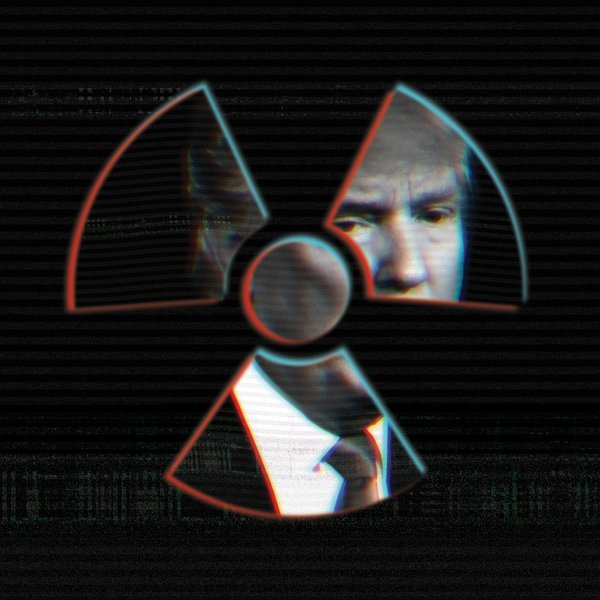
Scientists who study the risk of nuclear war recently moved the hands of the symbolic Doomsday Clock to 2½ minutes before midnight — meaning they believe that the world is closer to nuclear catastrophe than it has been since 1953 after the United States and Soviet Union tested hydrogen bombs. The Bulletin of the Atomic Scientists, which created the clock in 1947, says that President Trump is the main reason for this worrisome development.
Mr. Trump came to office with little knowledge of the vast nuclear arsenal and the missiles, bombers and submarines it contains. He has spoken, alarmingly, about deploying this weaponry against terrorists and about expanding America’s nuclear capabilities. He has said he values unpredictability, meaning presumably that he wants to keep other nations on edge about whether he will use nuclear weapons. (Read Complete Article).
"Nuclear Weapons Don't Belong in Anyone's Hands," by TIM WRIGHT, Feb. 15, 2017 The Nation
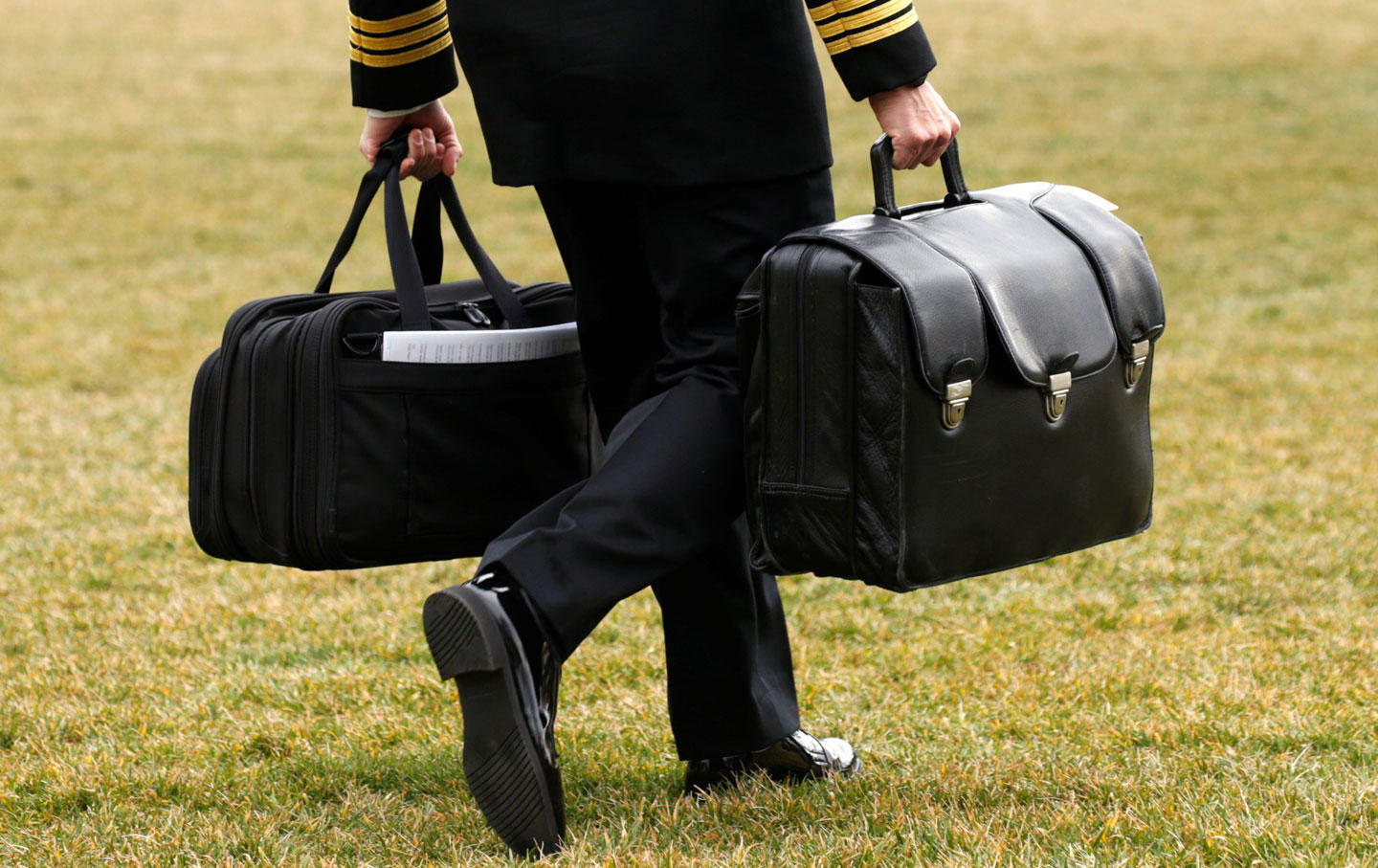
On January 20, amid the pageantry denoting the peaceful transfer of power in the United States, an unnamed military aide carrying a black leather satchel moved silently and solemnly from Barack Obama’s side and stood nearer Donald J. Trump. Within the innocuous-looking bag were the launch codes for America’s vast nuclear arsenal, comprising some 6,800 warheads, many on hair-trigger alert.
For the new commander in chief, it was “sobering” to be briefed that morning on the unparalleled destructive force now at his fingertips. “Very, very scary, in a sense,” he said in an interview. Like every US president since the dawn of the atomic age, Trump, upon taking the oath of office, gained sole authority to initiate nuclear war. No other US official need approve his decision. (Read Complete Article).
Senator Markey Denounces President Trump's Dangerous Ignorance of Nuclear Arms Treaty with Russia
FOR IMMEDIATE RELEASE
Contact: Giselle Barry (Markey) 202-224-2742
Senator Markey and Congressman Ted Lieu have introduced legislation prohibiting any American president from launching a nuclear first strike without a declaration of war by Congress
Washington (February 9, 2017) – Senator Edward J. Markey (D-Mass.), a member of the Foreign Relations Committee, released the following statement after Reuters reported today that President Donald Trump had a conversation with Russian President Vladimir Putin in which President Putin brought up the topic of the New START treaty, the agreement signed in 2010 that limits deployed nuclear warheads and delivery vehicles that will reduce the Russian nuclear threat. There was resounding support for New START from U.S. military leadership when the treaty was negotiated. Reuters reports that President Trump was unaware of the treaty during his conversation with President Putin, and then he denounced it as a "bad deal" for the United States. White House spokesperson Sean Spicer refused to comment on the conversation between Presidents Trump and Putin and the Reuters story during his daily press briefing today.
"The New START Treaty makes a vital contribution to U.S. national security by limiting the Russian nuclear weapons arsenal. That is why Secretary of State Rex Tillerson affirmed during his confirmation hearing his commitment to meet U.S. obligations under the treaty. If President Trump spoke with his own cabinet secretaries, he would know that nuclear arms control, and specifically the New START Treaty, strengthens American national security and preserves taxpayer dollars. Donald Trump's uninformed nuclear rhetoric is dangerous rhetoric and will only increase the risk of nuclear war.
"I call on President Trump to affirm his commitment to New START and disavow any efforts to launch a wasteful and destabilizing new nuclear arms race with Russia."
Confronting The Bomb
A group of 6 first-year undergraduate students from Princeton University decided that more young people, especially in high school and starting college, as well as the public needed to know more about nuclear weapons. They researched and scripted and made a series of 7 “crash course videos” on nuclear weapons, efforts at arms control, and the importance of the anti-nuclear movement.
The series of videos begins with a short “Introduction” and includes “Nuclear History Part 1” and “Nuclear History Part 2” and “Disarmament Movement Part 1” and “Disarmament Movement Part 2” and “Nuclear Bomb and Me Part 1” and Part 2, and there is a final video that is the “Conclusion”. You can see them by clicking here.
Click here to see the Lieu-Markey Bill to prohibit the conduct of a first-use nuclear strike absent a declaration of war by Congress
"Dems Seek to Limit Trump's Options for Using Nuclear Weapons" by REBECCA KHEEL Jan. 24, 2017 The Hill
Two Democrats are pushing Congress to restrict President Trump’s ability to launch nuclear weapons, reintroducing a bicameral bill Tuesday that would prohibit the president from launching a nuclear first strike without a declaration of war by Congress.
“Nuclear war poses the gravest risk to human survival,” Sen. Ed Markey (D-Mass.) said in a statement. “Yet, President Trump has suggested that he would consider launching nuclear attacks against terrorists. Unfortunately, by maintaining the option of using nuclear weapons first in a conflict, U.S. policy provides him with that power.” (Read Complete Article)
Stop Trump from Starting a New Nuclear Arms Race!
Op-ed by Coalition for Peace Action Executive Director Rev. Bob Moore
Published in the Trenton Times on 12/30/16
Before the Election, Donald Trump reportedly asked CIA briefers "If we have nuclear weapons, why can't we use them?" He also suggested that Japan, South Korea, and even Saudi Arabia should obtain their own nuclear weapons. He demonstrated no awareness or respect for the decades of bipartisan consensus for reducing and stopping the spread of nuclear weapons.
These were clear signs of an impulsive and reckless approach to the most sobering and awesome Presidential power of all: being able to single-handedly order the use of US nuclear weapons. Even before he gets that power, President-Elect Trump impetuously tweeted a threat to resume the nuclear arms race, wasting trillions of taxpayer dollars and recklessly imperiling the survival of humanity anew.
Mr. Trump is dramatically increasing the risk that accidents or miscalculation in the wake of this horrifying and unprecedented “anti-diplomacy through tweets” could cause a nuclear holocaust, hardly something US voters supported in the November 8 Election. A recent highly reputable study revealed that the use of even 100 of the 15,500 nuclear weapons remaining could cause two billion deaths—nearly one of every three people now living.
Former Secretary of Defense William Perry and other top nuclear experts have shared numerous examples of nuclear weapons almost being detonated in the nuclear arms race from 1945 until the first nuclear reduction treaty in 1987. A comment I have been hearing from such experts more frequently is that it is “mostly luck” that we haven’t had another use of nuclear weapons.
When the administration of former President Ronald Reagan recklessly talked of nuclear warning shots, and of fighting and “winning” a nuclear war, a massive citizen movement fought back and forced President Reagan to resume nuclear arms negotiations. Those led to the first nuclear reduction treaty in history in 1987.
Subsequently, Republican Presidents George H.W. Bush, and George W. Bush took steps to further reduce nuclear weapons, and Democratic Presidents Bill Clinton and Barack Obama acted similarly. The world’s nuclear arsenals have been reduced by over 75% as a result of this bipartisan policy of reducing the nuclear threat through verifiable agreements and initiatives.
The US Congress also acted wisely with bipartisan legislation for a moratorium on nuclear weapons testing, and for verifiably reducing the danger of “loose nukes.” The US Senate has also offered bipartisan ratification of each nuclear reduction treaty submitted to it.
I was honored and felt empowered to be a leader in the citizen movements that built pressure for, and has helped sustain momentum for such policies. We must again organize and mobilize, on an urgent basis, to oppose President-Elect Trump’s reckless steps toward a new nuclear arms race that could ultimately be suicidal for most if not all humanity.
Readers wanting more information or to get involved are urged to visit peacecoalition.org or call (609) 924-5022.
Click here for more information on Reducing the Waste in Nuclear Weapons Modernization, produced by Frank von Hippel
Nuclear Weapons- The Time for Abolition is Now by ROBERT DODGE
OCT. 31, 2016 ANTIWAR.COM
Nuclear weapons present the greatest public health and existential threat to our survival every moment of every day. Yet the United States and world nuclear nations stand in breach of the 1968 Nuclear Non-proliferation Treaty which commits these nations to work in good faith to end the arms race and to achieve nuclear disarmament. Forty eight years later the efforts of the nuclear nations toward this goal is not evident and the state of the world is equally as dangerous as it was during the height of the Cold War and arguably more dangerous with current scientific evidence on the catastrophic effects of even limited regional nuclear war. (Read Complete Article).
Click here to see a fact sheet on nuclear spending produced in collaboration with Massachusettes Peace Action.
Senator Al Franken has introduced a resolution to curtail spending on nuclear modernization
Click here to see the Franken Resolution on Nuclear Issues
Let’s Reduce the US Nuclear Arsenal by LAWRENCE WITTNER
NOV. 2, 2016 ANTIWAR.COM
At present, nuclear disarmament seems to have ground to a halt. Nine nations have a total of approximately 15,500 nuclear warheads in their arsenals, including 7,300 possessed by Russia and 7,100 possessed by the United States. A Russian-American treaty to further reduce their nuclear forces has been difficult to secure thanks to Russian disinterest and Republican resistance. (Read Complete Article).
US to the World: “We Can’t Eliminate Our Nukes, Because We Rely on Our Nukes" When the song remains the same, the dangers of nuclear weapons will never go away by KEVIN MARTIN
Nov. 3, 2016 COMMON DREAMS

Last week, the United Nations took an historic step towards global elimination of nuclear weapons, in voting to begin negotiations next year on a treaty to ban nukes. The U.S. and other nuclear weapon states, other than North Korea, declined to support the resolution, with the U.S. and its allies lobbying hard to defeat it. The contradictions in the official U.S. statement are myriad, but here are just a few. (Read Complete Article).
Why It's Safe to Scrap America's ICBMS by WILLIAM J. PERRY
SEPT. 30, 2016 The New York Times

In recent years, Russia and the United States have started rebuilding their Cold War nuclear arsenals, putting the world on the threshold of a dangerous new arms race. But we don’t have to repeat the perilous drama of the 20th century. We can maintain our country’s strength and security and still do away with the worst of the Cold War weapons.
The American plan to rebuild and maintain our nuclear force is needlessly oversize and expensive, expected to cost about $1 trillion over the next three decades. This would crowd out the funding needed to sustain the competitive edge of our conventional forces and to build the capacities needed to deal with terrorism and cyberattacks. (Read Complete Article).
Reduction of Nuclear Arsenal Has Slowed Under Obama, Report Finds The New York Times
A new census of the American nuclear arsenal shows that the Obama administration last year dismantled its smallest number of warheads since taking office.
The new figures, released by the Pentagon, also highlight a trend — that the current administration has reduced the nuclear stockpile less than any other post-Cold War presidency.
On Thursday, the Federation of American Scientists, a private group in Washington that strongly supports arms control, issued an analysis of the new figures on its Strategic Security blog. The annual Pentagon release did not appear to be linked to President Obama’s visit Friday to Hiroshima, Japan, which was destroyed by an American atomic bomb almost 71 years ago. (Read Complete Article)
Download a PDF Fact Sheet on "Say NO to the $Trillion Tax Dollar Nuclear Weapons Escalation!"
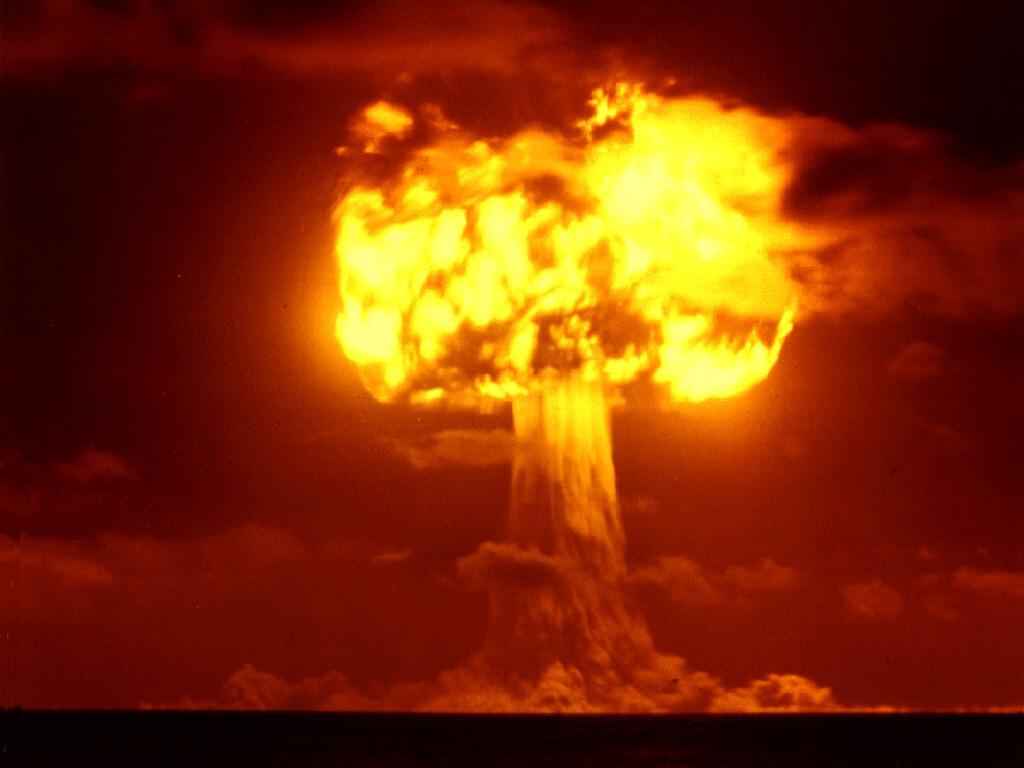
Leader of Region's Largest Grassroots Peace Group's Response to Obama's Visit to Hiroshima

Released: May 10, 2016
The Rev. Robert Moore, Executive Director of the Coalition for Peace Action (CFPA), the largest grassroots peace group in the region, responded with the statement below to today’s May 10 announcement that President Obama will include a visit in Hiroshima during his upcoming trip to Japan.
“I welcome President Obama’s decision to be the first sitting President in the nuclear age to visit Hiroshima, the site of the first use of nuclear weapons during World War II. This has great symbolic significance, especially following the President’s inspirational speech calling for a world without nuclear weapons in Prague in 2009.
Remembering the utter horror and destruction wreaked by a relatively small nuclear weapon, compared to today’s nuclear weapons, is crucial to generating the global will to move toward abolishing such weapons worldwide. But we can’t get that result just with lofty speeches; concrete actions are needed.
Ironically, since the last nuclear reduction treaty in 2010 (New START ), no further negotiations or treaties toward further reductions have occurred. Instead, the US has plans to re-build its entire nuclear arsenal in ways that escalate its destructive capabilities and likelihood of being used, costing $1 trillion! Russia, North Korea and others are also starting to build up nuclear weapons. The world is on the verge of a new nuclear arms race.
President Obama shouldn’t go empty handed to Hiroshima. I urge him to announce one or more of the steps below:
1. Take nuclear weapons off hair trigger alert. This long-term policy has brought the world to the brink of accidental nuclear war, and could be implemented with the President’s Commander in Chief authority.
2. Reduce US deployed long-range nuclear weapons from 1,550 under New Start to 1,000—a level the military says is adequate for deterrence—and challenge Russia to respond by also reducing to that level or below.
3. Initiate negotiations for a Treaty to globally and verifiably ban nuclear weapons. Verifiable international bans on Chemical and Biological Weapons have been successfully negotiated and implemented. It’s time to heed the obligation nuclear weapon states have under Article 6 of the Nuclear Non-proliferation Treaty to negotiate the ultimate abolition of their arsenals.
I too have been to Hiroshima, and found it to be a powerful reminder of the unimaginable destruction that would result if nuclear weapons are ever used again. I urge President Obama to announce concrete steps toward a world free of nuclear weapons, in which future generations can live their lives without the specter of global nuclear destruction constantly hanging over them.”
With over 7,800 member and supporting households, the Princeton-based Coalition for Peace Action is the largest grassroots peace group in the region, with staff and chapters in central and southern NJ and Southeastern PA. Rev. Moore has served as executive director since 1981, and also currently serves as Co-Pastor of Christ Congregation in Princeton.
The Rev. Robert Moore
Executive Director
Coalition for Peace Action &
Peace Action Education Fund
40 Witherspoon St.
Princeton, NJ 08542
609-924-5022
cfpa@peacecoalition.org
Race for Latest Class of Nuclear Arms Threatens to Revive Cold War
APRIL 16, 2016 The New York Times

The United States, Russia and China are now aggressively pursuing a new generation of smaller, less destructive nuclear weapons. The buildups threaten to revive a Cold War-era arms race and unsettle the balance of destructive force among nations that has kept the nuclear peace for more than a half-century.
It is, in large measure, an old dynamic playing out in new form as an economically declining Russia, a rising China and an uncertain United States resume their one-upmanship.
American officials largely blame the Russian president, Vladimir V. Putin, saying his intransigence has stymied efforts to build on a 2010 arms control treaty and further shrink the arsenals of the two largest nuclear powers. Some blame the Chinese, who are looking for a technological edge to keep the United States at bay. And some blame the United States itself for speeding ahead with a nuclear “modernization” that, in the name of improving safety and reliability, risks throwing fuel on the fire. (Read Complete Article)
The Center for Arms Control and Non-proliferation -
"US Nuclear Arsenal: Costs & Constraints" Modernization Breakdown Fact Sheet March 2016 Downloadable PDF
President Obama: Lead us to a World Free of Nuclear Weapons!
(Sign Letter to President Obama Below)
Survivors of nuclear blasts - from Hiroshima, Nagasaki, the Marshall Islands, Korea, and the Southwest United States - tell us that nuclear weapons inflict scenes of "hell on Earth," and that "humanity cannot live alongside nuclear weapons." The U.S. must do more to advance the total abolition of nuclear weapons.
President Obama: Lead us to a World Free of Nuclear Weapons!
As you stated in Prague in April of 2009, "The existence of thousands of nuclear weapons is the most dangerous legacy of the Cold War."
Now, please take action to save the world from nuclear disaster:
Take our missiles off hair-trigger alert.
Commit that the United States will never be the first to use nuclear weapons.
Implement the Nuclear Non-Proliferation Treaty, to begin negotiations among all nuclear weapons states for the elimination of the world's nuclear arsenals.
Stop the $1 trillion program of modernizing nuclear weapons and shift the funds to housing, child health, public transit, infrastructure renewal, education, and green economic development.
(Sign Petition to tell President Obama to Lead us to a World Free of Nuclear Weapons!)
President Obama: Lead us to a World Free of Nuclear Weapons!
Survivors of nuclear blasts - from Hiroshima, Nagasaki, the Marshall Islands, Korea, and the Southwest United States - tell us that nuclear weapons inflict scenes of "hell on Earth," and that "humanity cannot live alongside nuclear weapons." The U.S. must do more to advance the total abolition of nuclear weapons.
President Obama: Lead us to a World Free of Nuclear Weapons!
As you stated in Prague in April of 2009, “The existence of thousands of nuclear weapons is the most dangerous legacy of the Cold War.”
Now, please take action to save the world from nuclear disaster:
Take our missiles off hair-trigger alert.
Commit that the United States will never be the first to use nuclear weapons.
Implement the Nuclear Non-Proliferation Treaty, to begin negotiations among all nuclear weapons states for the elimination of the world’s nuclear arsenals.
Stop the $1 trillion program of modernizing nuclear weapons and shift the funds to housing, child health, public transit, infrastructure renewal, education, and green economic development.
- See more at: http://org.salsalabs.com/o/161/p/dia/action3/common/public/?action_KEY=18080#sthash.qhekaAZV.dpuf
Let’s End the Peril of a Nuclear Winter
FEB. 11, 2016
|The Opinion Pages, The New York Times
IN the early 1980s, American and Russian scientists working together outlined a stark vision of the Cold War future. In a battle between the two superpowers, smoke from fires ignited by nuclear explosions would be so dense that it would block out the sun, turning the earth cold, dark and dry, killing plants and preventing agriculture for at least a year.
This dystopia became known as nuclear winter.
We haven’t heard much about this apocalyptic future in recent years. But the research into the destructive potential of a war involving nuclear weapons has continued. Even with the reduced nuclear arsenals that the United States and Russia agreed to in 2010, we have the ability not only to set off instantaneous destruction, but also to push global temperatures below freezing, even in summer. Crops would die and starvation could kill most of humanity.
But it is not just the superpowers that threaten the planet. (Read Complete Article)
New Report: Nuclear Modernization Plans are Unsustainable
January 28, 2016 | Edited by Cora Henry and Noah Williams
On the radar: The Crippling cost of remodeling nukes; Kerry warns China about North Korea; Convincing North Korea to give up the bomb; We’re still three minutes till midnight; Israel calls for end to nuclear tests; 50,000 Estimated to join anti-nuke protest. (Read Complete Report Here)
Increasing Accuracy and Flexibility in Nuclear Weapons Actually Undermines Arm Control
When nuclear weapons become user-friendly, they will be used.
By , January 15, 2016 Foreign Policy in Focus 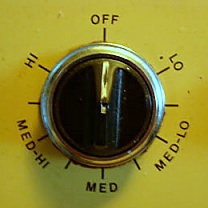
The B-61 is 12-foot-long, 700-pound thermonuclear (hydrogen) bomb that has been a stalwart of the U.S. nuclear weapons arsenal since the 1960s. (Hey, at least it’s not as old as the B-52 bomber, which first flew in — you guessed it — 1952.) Its re-design, which now makes it the B-61-12, has generated even more controversy than nuclear weapons in general. Here are three of the sticking points.
First, the cost of refurbishing the U.S. nuclear weapons program: Up to $1 trillion over 30 years, it does — under the department of thank-goodness-for-small favors — lend credence to those who think that the program will die a slow death due to budgetary attrition.
Second, the B-61-12’s re-design: Is it actually a new weapon or just “modernization,” in accord with the administration’s stated aims to create no new nuclear weapons? Granted, it doesn’t seem like much in these days of precision-guided munitions and Minuteman ICBMs (intercontinental ballistic missiles), but one new feature of the B-61-12 is that it can be steered via movable tail fins. Previously air-to-surface nuclear bombs (those deslivered by fighters and bombers) were just dropped.
American Casualties of the U.S. Nuclear Weapons Program
By Lawrence Wittner Huffington Post Politics

When Americans think about nuclear weapons, they comfort themselves with the thought that the vast, nuclear destruction of human life has not taken place since 1945 -- at least not yet. But, in reality, nuclear weapon-related destruction has taken place, with shocking levels of U.S. casualties.
This point is borne out by a recently-published study by a team of investigative journalists at McClatchy News. Drawing upon millions of government records and large numbers of interviews, they concluded that employment in the nation's nuclear weapons plants since 1945 led to 107,394 American workers contracting cancer and other serious diseases. Of these people, some 53,000 judged by government officials to have experienced excessive radiation on the job received $12 billion in compensation under the federal government's Energy Employees Occupational Illness Compensation Program. And 33,480 of these workers have died. (Read Complete Article)
'Modernizing' the Opportunities for Nuclear War
A fight now underway over newly-designed U.S. nuclear weapons highlights how far the Obama administration has strayed from its commitment to build a nuclear-free world.
The fight, as a recent New York Times article indicates, concerns a variety of nuclear weapons that the U.S. military is currently in the process of developing or, as the administration likes to say, "modernizing." Last year, the Pentagon flight-tested a mock version of the most advanced among them, the B61 Model 12. This redesigned nuclear weapon is the country's first precision-guided atomic bomb, with a computer brain and maneuverable fins that enable it to more accurately target sites for destruction. It also has a "dial-a-yield" feature that allows its handlers to adjust the level of its explosive power. (Read Complete Article)
Civil Society: NPT Review Conference Fails, Brings World Closer to Nuclear Cataclysm, IPS News, By Thalif Deen, 5/24/2015
What happened? The 2015 Non-Proliferation Treaty Review Conference in New York fails to deliver, despite a solid draft Final Document.
This is the critical conference that reviews progress on the central nuclear non-proliferation and disarmament Treaty Regime. The United States, UK, and Canada broke the consensus on the draft agreement contained in the Final Document, to convene the proposed Middle East WMD-Free Zone conference in 2016. “No meaningful progress was made”, said Ray Acheson, director of Reaching Critical Will, and the Women’s International League for Peace and Freedom, the oldest US-based peace group.
John Burroughs, executive director of the Lawyers Committee on Nuclear Policy, told IPS the problem with NPT Review Conference commitments on disarmament “is not so much that they have not been strong enough. Rather the problem is that they have not been implemented by the NPT nuclear-weapon states.” In fact, Civil Society leaders from around the world condemned the failure of the agreement.
The Proposed Final Document recommended the General Assembly establish an open-ended working group to “identify and elaborate” effective disarmament measures, including legal agreements for the achievement and maintenance of a nuclear weapons free world. "Regardless of the lack of an NPT outcome, this initiative can and should be pushed at the next General Assembly session on disarmament and international security” this autumn, said John Burroughs.
Joseph Gerson, of the American Friends Service Committee: “The United States was primarily responsible” for the failure of this year’s critically important NPT Review Conference. “The U.S., Britain and Canada are blaming the victim,” saying Egypt wrecked the conference with a renewed call for creating a Middle East Nuclear Weapons-Free Zone.
“Israeli apparently refused (a compromise), and U.S. President Obama’s ostensible commitments to a nuclear weapons-free world melted in the face of Israeli intransigence,” said Gerson.
Ray Acheson: The majority of the world’s countries (Parties to the Treaty)—have endorsed a Humanitarian Pledge, committing to fill the legal gap for the prohibition and elimination of nuclear weapons. “The outcome in 2015 is that Humanitarian Pledge.” __________________________________________
CFPA Comments: John Burroughs, one of International Civil Society’s leading anti-nuclear advocates, says fulfilling the Humanitarian Pledge doesn’t require the permission of the nuclear-armed States. “The process should begin without delay.” We agree. Hiroshima must never happen again, and we have no time to lose.
In the 1990’s, there was a similar case. The U.S. and both Koreas refused to sign the Treaty Banning Land Mines. But the world went ahead, we have a functioning Land Mines Treaty, and the U.S. participates in disarming land mines that risk civilians’ lives all over the world. Today, many countries are willing to sign a Treaty Banning the Possession and Use of Nuclear Weapons. The way international law works, when most have signed on, use of nuclear weapons becomes illegal under customary international law. The same should be true of keeping such weapons on hair-trigger alert. Eventually, the nuclear powers will see its wisdom, comply, and sign.
A Treaty to Ban Nuclear Weapons, in order to “build a new reality of human security and global justice” would be pursued under the main consensus. Polls show 3 out of 4 people around the world agree.
2015 in New York shows a failure of moral and strategic leadership by the five Permanent Members of the UN Security Council, including the United States. It is our duty to actually lead the way to nuclear security, which means abolition. Nuclear Weapons are reaching 70—well past their retirement age. Let's all hear John Burroughs in Princeton, at the CFPA 35th Membership Dinner and Program! Let's have a party to send them off!
Ed Aguilar, CFPA Pennsylvania, May 27, 2015
Edward A. Aguilar, J.D.
Pennsylvania Director
Coalition for Peace Action
Friends Center, 1515 Cherry Street
Philadelphia, PA 19102
To print a downloadable pdf petition Appeal for a Total Ban on Nuclear Weapons for your distribution, Click Here!
Will the U.S. Get Serious Now About Eliminating Its Own Nukes?
The Iran nuclear deal could provide momentum for a nuclear weapons-free Middle East — and eventually a nuclear-free world.
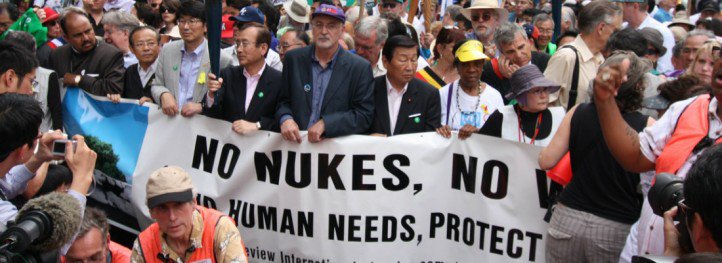
By Jacqueline Cabasso, Joseph Gerson and , April 16, 2015.
A few years ago, a plucky contestant on Dancing with the Stars popularized a terrific phrase when asked about her daring routine late in the contest. It was time, she quipped, for her to “go big or go home.”
We’d like to see that can-do attitude manifested at the upcoming UN review conference on the Non-Proliferation Treaty — the so-called NPT RevCon .
What would going big mean? A serious commitment by the nuclear powers to get busy negotiating the global elimination of nuclear weapons, as required by the treaty’s Article VI. The conference will convene April 27 and run through May 22. (To read complete article, Click Here.)
A Picture is Worth a Thousand Words,
and this one 16,400.
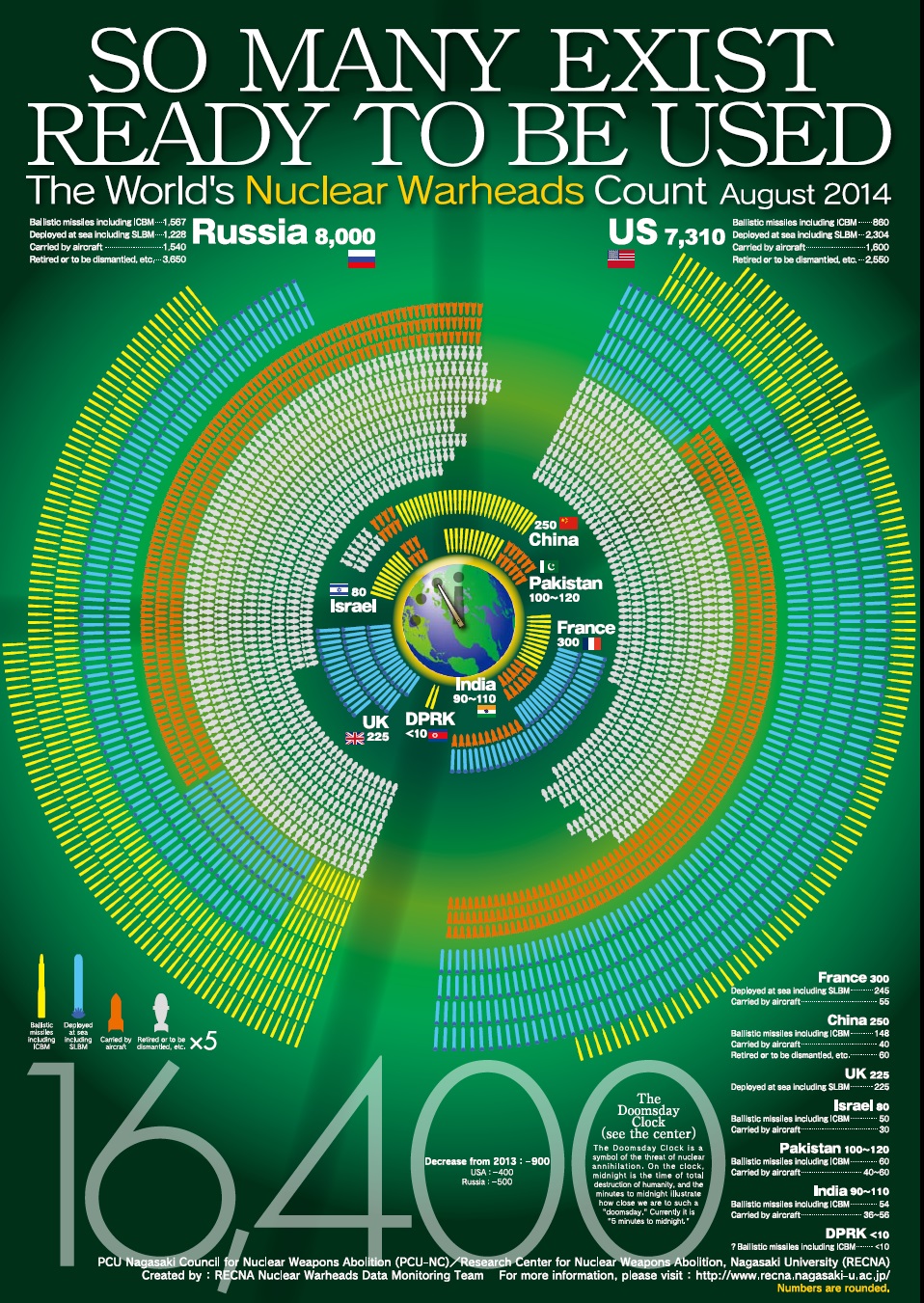
Which President Cut the Most Nukes?
By WILLIAM J. BROAD November 1, 2014 New York Times
DOVES who once cheered President Obama for his antinuclear crusades and later fell silent as he backpedaled are now lining up to denounce him. A recent skewering by the Federation of American Scientists details how Mr. Obama, despite calling repeatedly for “a world without nuclear weapons,” has reduced the size of the nation’s atomic stockpile far less than did any of his three immediate predecessors, including both Presidents Bush.
Critics are calling out the president not only for modest cuts but also for spending more than previous administrations to modernize the remaining arms and for authorizing a new generation of weapon carriers. They call the upgrades an enormous waste of money, citing estimates that put the nation’s costs over the next three decades at up to a trillion dollars. (to read complete article Click Here)
CFPA on Nuclear Weapons
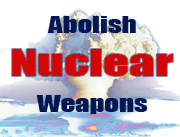
President Obama - following in the footsteps of Ronald Reagan - has called for the complete abolition of nuclear weapons. These dangerous, expensive weapons, which have been called the "ultimate" weapon, have provided little value to the United States (or any country.) They are a catastrophe waiting to happen and they don't deliver appreciable security. The passing of New START in December of 2010 was a great victory that presents peace activists with a renewed optimism that we can carry into our further endeavors to ban nuclear weapons.
CFPA Campaign Timeline

- Showing of Hibakusha Film: On March 6, 2011, CFPA hosts a showing of the film "Hibakusha: Our Life to Live," which focuses on the lives of survivors of nuclear attack, and has been shown at the UN, in Japan, and in cities around the United States. The film is shown to a packed auditorium, with a discussion afterwards led by the filmmaker, David Rothauser.
- New START Treaty: During the fall and winter of 2010, CFPA engaged in important efforts advocating for the ratification of New START, which will limit Russian and US nuclear arsenals to 1,550 warheads. CFPA phoned senators in key swing states and nurtured Senators Bob Casey and Robert Menendez as champions for nuclear disarmament. We then celebrated this great victory with a light dinner and champagne toast!
- Hiroshima and Nagasaki Commemorations: Every August, CFPA commemorates the bombings of Hiroshima and Nagasaki. The commemoration often consits of a talk from one of the attack's survivors, Japanese music, and a time of reflection with songs and floating candles on a lake (a tradition during the Japanese commemorations of the bombings).
- CFPA Begins PAZ Campaign: In May 2010, CFPA began its PAZ (The Pennsylvania Zero Nuclear Arms) Campaign. The Campaign’s primary goal is to support and nurture Sen. Bob Casey, who is Chair of the Senate Foreign Relations Committee Subcommittee on South Asia and the Middle East, to be a champion for global nuclear disarmament. During the START debate, Casey made a fantastic floor speech in support of the treaty, which was a testament to his integrity and also to the effectiveness of this grassroots campaign!
- Earth Day Rally for Nuclear Weapons Abolition: On April 22, 2010, CFPA co-sponsored an Earth Day Rally for Nuclear Weapons in support for young interfaith peace walkers, who were kicking off their Peace Walk for Nuclear Abolition. CFPA's executive director, the Rev. Robert Moore, was among the event's speakers.
- Peace Train to Global Nuclear Disarmament: On May 2, 2010, CFPA co-sponsored a Peace Train to Global Nuclear Disarmament held by our affiliate, United for Peace and Justice. People boarded trains in the Deleware Valley area and rode them up to New York City, then concluded the event with a rally. The event took place the day before the UN held a Major Review Conference for the Nuclear Non-Proliferation Treaty.
__________________________________________________________________________________________________
On the Anniversary of Cuban Missile Crisis an Historic Opportunity
By Maj. Gen. Roger R. Blunt (ret.)*
Fifty years ago the biggest event in human history almost happened. During a fateful 13-day period in October 1962, the Soviet Union and the United States balanced at the brink of nuclear war as the Soviets attempted to establish nuclear bases in Cuba.
I had just graduated with my degree in nuclear engineering from MIT and reported to the Army nuclear power program at Fort Belvoir in Virginia. All of us spent the week glued to the TV wondering if the world's first nuclear war was about to begin. I will never forget the relief we felt when we learned that, thanks to the vision and restraint of a handful of people, this point in history would be marked by what did not occur.
What President Kennedy and his advisers didn't know as they contemplated an invasion of Cuba was that the Soviets already had tactical nuclear weapons on the island. An invasion could have started a nuclear exchange. Kennedy's advisers gave him two alternatives: an invasion or a naval blockade. Kennedy chose a blockade. Soviet President Nikita Khrushchev chose to remove the bases. Somehow, through all that tension, better sense prevailed. And the rest, as they say, is history.
Sadly though, the costs of our nuclear posture are not. We have a Cold War nuclear arsenal built to defend us from "Mad Men"-era threats. But those threats, like the three-martini lunch, are a thing of the past. And the over half a trillion dollars we're going to spend on maintaining that bloated arsenal over the next decade will be a half trillion less we can spend on the training and equipment our troops need to face 21st-century threats.
Today, President Obama has the opportunity to bring a Cold-War era policy into the 21st century and is readying a presidential policy review for our thousands-strong nuclear arsenal. What the president decides to do impacts everything from where and how the weapons are targeted to whether or not we reshape our stockpile to reflect modern needs.
For example, for the cost of one new ballistic nuclear submarine, we could provide body armor and bomb-resistant Humvees to all our troops overseas, house and treat every homeless veteran, and still have $2.2 billion left over to pay down the debt. And that is just the cost of one of the 13 new subs Congress is trying to force on the Pentagon. Our troops and security should come before pork-barrel nuclear programs.
Re-shaping our nuclear force is an issue of vision and conscience. We need the vision to recognize our world has changed, and we can't allow pork-barrel spending and bureaucratic inertia to shape our national security priorities.
As a matter of conscience, we should remember that weapons are still pointed at civilian targets, and we haven't even adopted appropriate safe guards that would reduce the chance of accidental launch. A single strike on a city can kill millions of people. And if the United States remains mired in Cold War attitudes, it makes it harder for us to lead in the effort to reduce and lock up nuclear stockpiles in other countries, which increases the risk of a nuclear weapon falling into the hands of terrorists.
It's up to the president to buck bureaucratic inertia and have the vision to confront the threats and costs our bloated stockpile has created. This week, more than a hundred political and faith leaders have signed a joint letter asking the president to do just that. They join military leaders like former Secretary of Defense Bill Perry and former chairman of the Senate Armed Services Committee, Sam Nunn, who have long pushed policy-makers to reduce the role of weapons in security strategy, trim stockpiles and shave millions from the budget. I hope the president and Congress listen.
*ABOUT THE WRITER
Maj. Gen. Roger R. Blunt (retired) commanded the 97th Army Reserve Command and has been awarded the Distinguished Service Medal. He served with the U.S. Army Corps of Engineers and held the career designator of Atomic Energy Officer.
The Campaign for a Nuclear Weapons Free World/Peace Action West worked with Eric Sapp/AVN and ReThink on this piece referencing the CMC, the organizational sign-on letter to the President, and the nuclear policy guidance. This article was picked up by the McClatchy wire service, and various outlets across the country on October 19 and 20, 9012. The opinions are those of the writer and do not necessarily represent the views of McClatchy-Tribune or its editor.
Resources

- "Your Doctors Are Worried," A Huffington Post article by Lawrence Wittner, Professor of History Emeritus SUNY Albany 04/15/14
- "Trimming the Bloated Nuclear Weapons Budget," Arms Control Association, 01/15/14
- "Throwing Money at Nukes,"New York Times editorial
- The Real Cost of Nuclear Weapons: CFPA Fact Sheet
- Days of Blank Checks are Over for Nuclear Weapons Establishment, The Hill 04/26/13
- Nuclear Time Warp, excellent lead editorial in 6/10/12 NY Times
- "Nuclear Weapons Just Don't Make Sense," Walter Pincus, Washington Post
- "Panel Calls for Steep Cuts in US Nukes," San Francisco Chronicle
- Summary of the SANE Act from Rep. Markey's office
- Nuclear Famine: A Billion People at Risk; report from Physicians for Social Responsibility on the effects of a limited nuclear war
- SANE Act Fact Sheet from Friends Committee on National Legislation
- "Try a Little Nuclear Sanity on For Size," Lawrence Wittner,
- "The Nuclear Implementation Study," New York Times
- "Put Nukes on the Chopping Block," Katie Heald, Coordinator of Campaign for a Nuclear Weapons Free World
- A Breakdown of the President's 2013 Budget Request by Campaign for a Nuclear Weapons Free World
- "New Nuclear Math: It's About Time," Mark Thompson, TIME Magazine
- "Obama Administration Weighing Deep Cuts to Nuclear Force," Huffington Post
- "Nuclear Studies and Republican Disarmers," Federation of American Scientists Strategic Security Blog
- Watch CFPA's 31st Annual Conference: "Global Abolition of Nuclear Weapons: An Idea Whose Time Has Come":Part 1 with Dr. Zia Mian; Part 2 with Kevin Martin
- "From Hiroshima to Fukushima: Japan's Nuclear Disasters" by Amy Goodman
- Peace Action West: Nuclear Nonproliferation Funding
- "Detterence in the Age of Nuclear Proliferation," an editorial by George P. Schultz, William J. Perry, Henry A. Kissinger and Adam Nunn
- Senate Briefing Packet to help Educate US Senators to take leadership for Nuclear Disarmament
- Peace Action Initiative on Nuclear Weapons: a summary of the position and initiatives of Peace Action (the national group we are affiliated with) on nuclear weapons.
- Top ten reasons why nuclear weapons still exist (Humor from your own Coalition staff) "Reason number 10: Who needs schools, hospitals, day care, better roads, education, public housing, clean water, universal health care, solar power, crop supports, wind mills, disaster response, etc. etc. etc.?"
- Nuclear Threat Initiative A middle-of-the-road to conservative site calling for the abolition of nuclear weapons.
- Blog: Rethinking Nuclear Weapons The personal blog of Ward Wilson, former Associate Director of the Coalition for Peace Action.
[Got a resource on nuclear weapons? Send us a recommendation and a link!]

